Jeju & Seogwipo Street Food - Part 1
Jeju & Seogwipo Street Food is part of the larger tapestry of Korean cuisine in South Korea. Unique for being a largely standalone cuisine, with little outside influence, Korean cuisine originated from an agricultural society, and through interaction with the natural environment. Jeju & Seogwipo Street Food differs in several aspects compared to the mainland, and is largely reliant on local produce and farm stock. There is a heavier emphasis on freshness of ingredients, and in the making of soups and stews.
 |
| Saengseon-Hoe - Sea Bream |
Food in Jeju & Seogwipo can be found along the streets in pushcarts or small cafes, in mid-range restaurants, and fine-dining establishments. Korean cuisine is largely based on rice and legumes, with dishes being heavy on seasoning, and usually include fermented items. As a result, many dishes taste tangy, salty, sour, or spicy. Common ingredients used in many Jeju & Seogwipo and South Korea dishes include white rice, soybeans, tofu / beancurd, Tteok / Dduk / rice cakes, sesame oil, doenjang / fermented soybean paste, soy sauce, salt, garlic, ginger, gochujang / fermented red chili paste, cabbage, barley, buckwheat, mung beans, adzuki red beans, vinegar, onions, pork, mackerel fish, hairtail fish, Pacific herring fish, anchovies, shrimp / prawns, octopus, cuttlefish, squid, abalone, cucumber, potato, sweet potato, spinach, bean sprouts, seaweed, zucchini, mushrooms, tangerines, chili and more.
The Jeju Special Administrative Province in South Korea is reowned for 2 specialities; black pork and fresh seafood. These feature heavily on menus here, to the extent that other options such as chicken or beef are limited, and the quality usually isn't as good. Meals in Jeju & Seogwipo follow the same Korean etiquette, with the eldest normally being served first, dishes laid out on the table in a specific order, and meals eaten in silence.
.....
The Seolleongtang / Beef Bone Soup is a hearty soup / broth, made by boiling beef leg bones, creating a stock which is translucent in appearance, with a rich meaty savoury sweet flavour. A staple in most households, it's garnished with thin chewy lean beef brisket, rice noodles / white rice, salt, pepper, and chopped spring onions. Simple comfort dish.
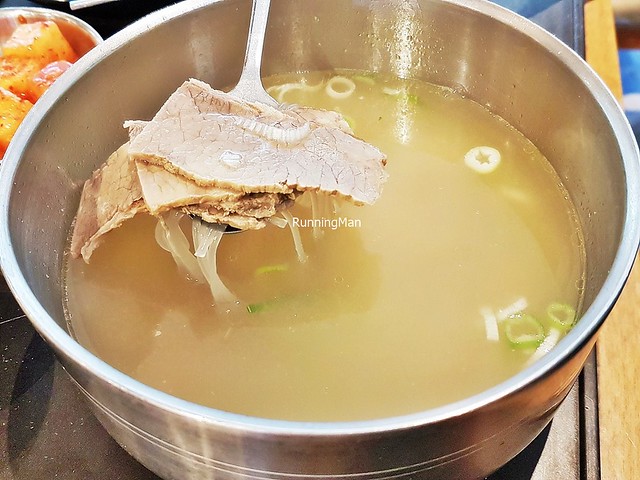 |
| Seolleongtang / Beef Bone Soup |
 |
| Seolleongtang / Beef Bone Soup |
The Beer Jeju Wit Ale is a Belgian style Witbier, brewed in Hallim-Eup, Jeju & Seogwipo, Jeju Special Administrative Province, South Korea, using natural spring water and local tangerines. It has a cloudy, pale golden colour, with aromas of orange, wheat, hops, and coriander. Body is light, thin, and smooth, with tastes of tangerine, bread, clove, and lemon. The zesty fruity sweetness is refreshing and thirst-quenching, perfectly matching the climate of the island.
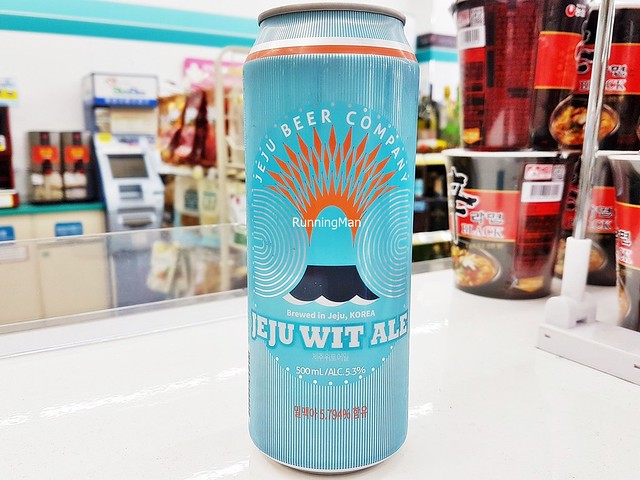 |
| Beer Jeju Wit Ale |
The Boiled Pork Hocks is a traditional dish, owing to the premium quality of the local pigs. The pig's trotters are slow boiled with water, light soy sauce, ginger, garlic, and rice wine. Sometimes, spring onions, cinnamon, or leeks are added. The resulting texture is bouncy and gelatinous, with a robust savoury flavour. Served in large communal portions, it's actually eaten to accompany a meal, or as a bar snack.
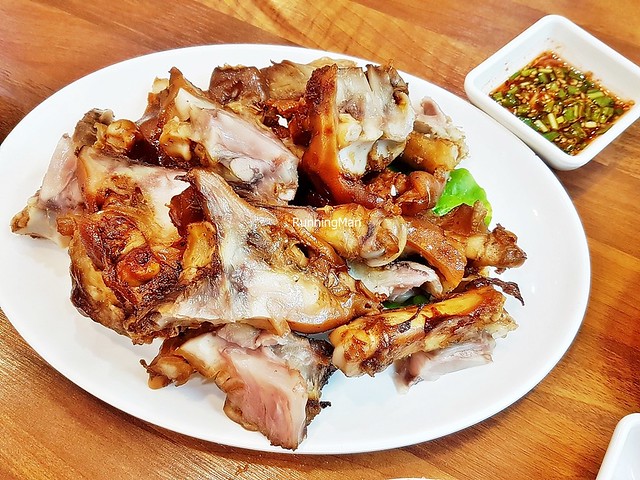 |
| Boiled Pork Hocks |
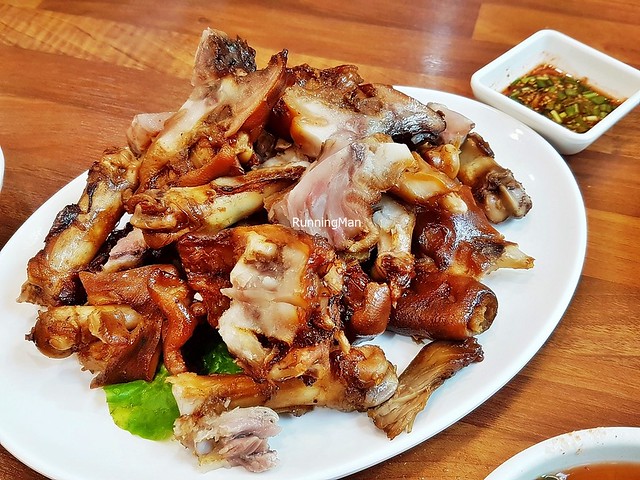 |
| Boiled Pork Hocks |
The Chestnut Bread is a modern confectionery, featuring fluffy soft brioche bread studded with crunchy chestnuts. The flavour is delicate sweet nutty. Crafted and baked by local cafes here.
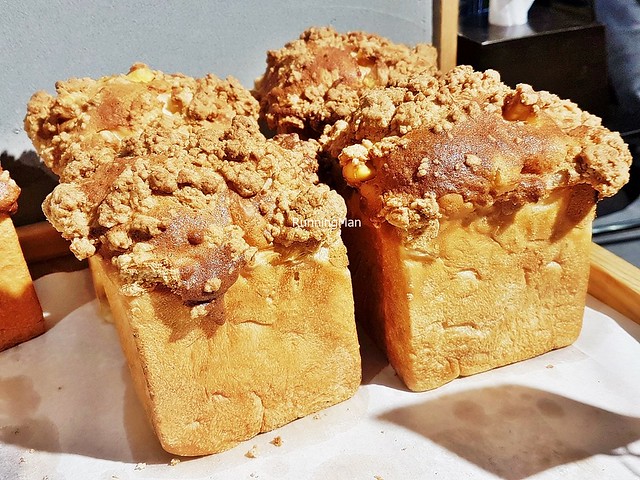 |
| Chestnut Bread |
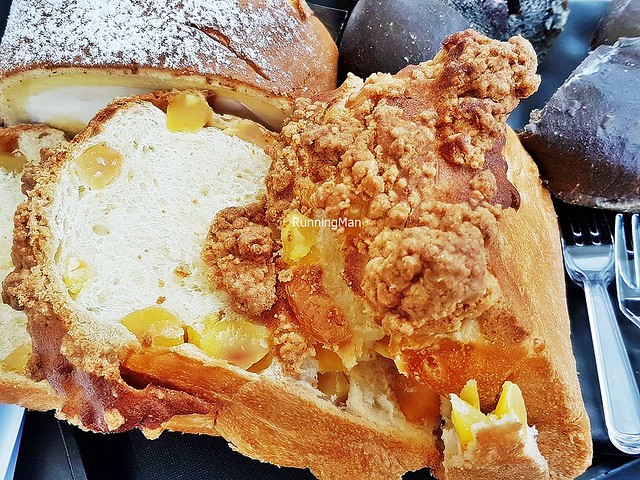 |
| Chestnut Bread |
This South Korean beverage is not a cider per se. Rather, Chilsung Cider is a carbonated soft drink, clear and fizzy, similar to a lemon lime soda. Refreshing when chilled, it has a sticky zesty tangy sour sweet flavour.
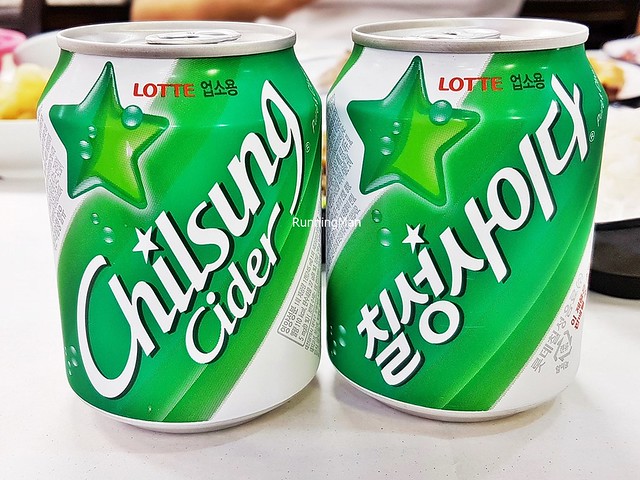 |
| Chilsung Cider |
A popular side dish here, the Cream Corn features corn kernels tossed in a light butter and mayonnaise, served on a hot plate to keep it warm. Other variations on this add mozzarella cheese, making it more filling.
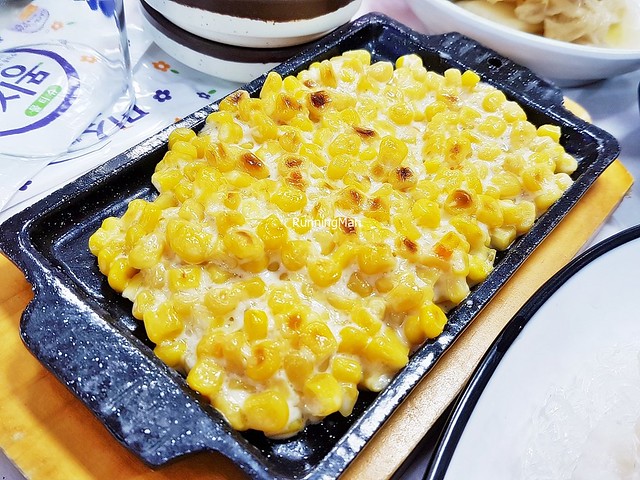 |
| Cream Corn |
Considered an iconic dish of Jeju & Seogwipo, the Cutlassfish Soup / Largehead Hairtail Fish Soup features the island's signature fish - the long, slender, silver skinned cutlassfish / largehead hairtail fish, which has tender flaky fish meat and a delicate sweet savoury flavour. This traditional dish features the fish, simply boiled in water, along with salt, cabbage, kabocha squash, leeks, tofu beancurd, and spring onions. The warm soup / broth is light on the palate, and typically served to round-off a meal.
 |
| Cutlassfish Soup / Largehead Hairtail Fish Soup |
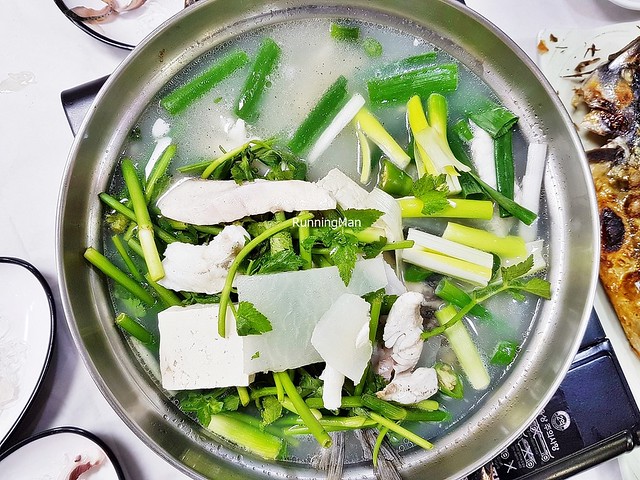 |
| Cutlassfish Soup / Largehead Hairtail Fish Soup |
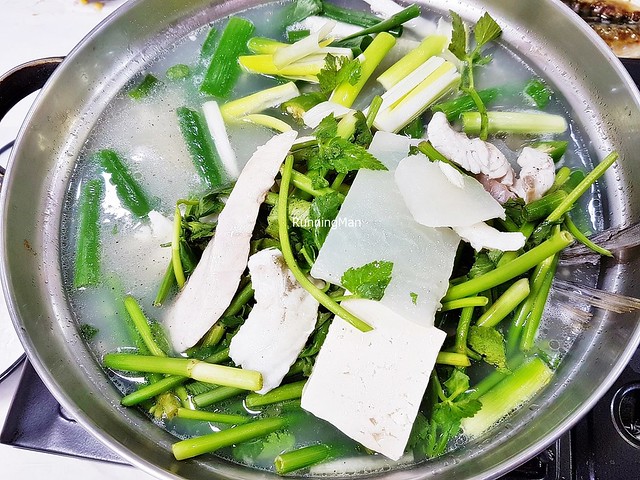 |
| Cutlassfish Soup / Largehead Hairtail Fish Soup |
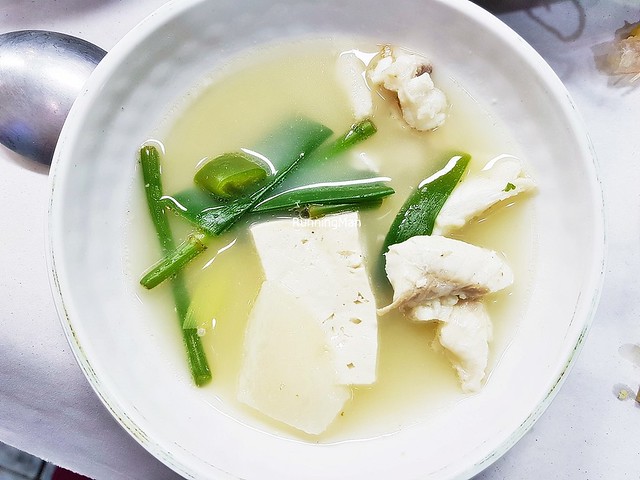 |
| Cutlassfish Soup / Largehead Hairtail Fish Soup |
The Galchi Jorim / Braised Cutlassfish Spicy Stew / Braised Largehead Hairtail Fish Spicy Stew is the spicy stew version of the island's signature dish. It features the cutlassfish / largehead hairtail fish, with its tender flaky texture and delicate sweet savoury flavour, braised with water, salt, tender kabocha squash, tender daikon radish, crisp spring onions, and gochujang / fermented red chili paste. This stewed dish has a strong fishy taste, a robust sweet savoury salty spicy flavour, and a thick gloopy texture to the gravy, which the locals seem to like.
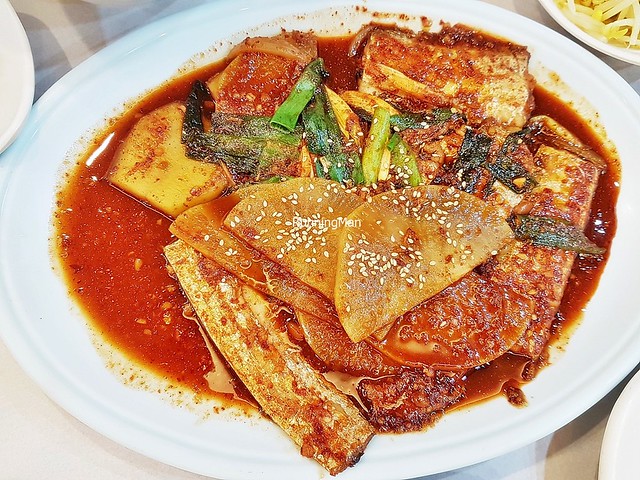 |
| Galchi Jorim / Braised Cutlassfish Spicy Stew / Braised Largehead Hairtail Fish Spicy Stew |
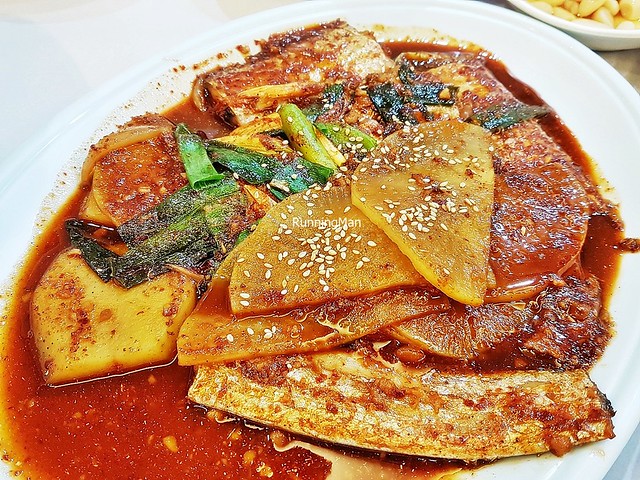 |
| Galchi Jorim / Braised Cutlassfish Spicy Stew / Braised Largehead Hairtail Fish Spicy Stew |
 |
| Galchi Jorim / Braised Cutlassfish Spicy Stew / Braised Largehead Hairtail Fish Spicy Stew |
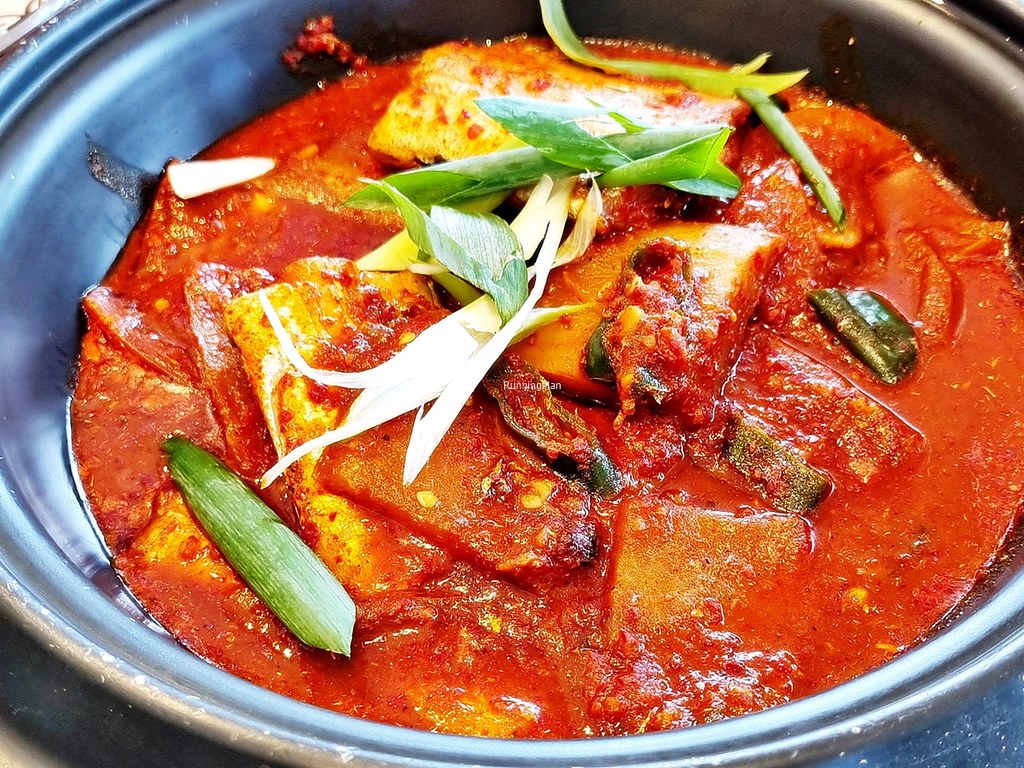 |
| Galchi Jorim / Braised Cutlassfish Spicy Stew / Braised Largehead Hairtail Fish Spicy Stew |
 |
| Galchi Jorim / Braised Cutlassfish Spicy Stew / Braised Largehead Hairtail Fish Spicy Stew |
Served as a side dish, the Daepa / Asian Leeks features crunchy Asian leeks tossed in a light soy sauce, giving it a bright yet salty flavour. Served to accompany dishes whose flavours are light and clean, providing a nice foil in taste.
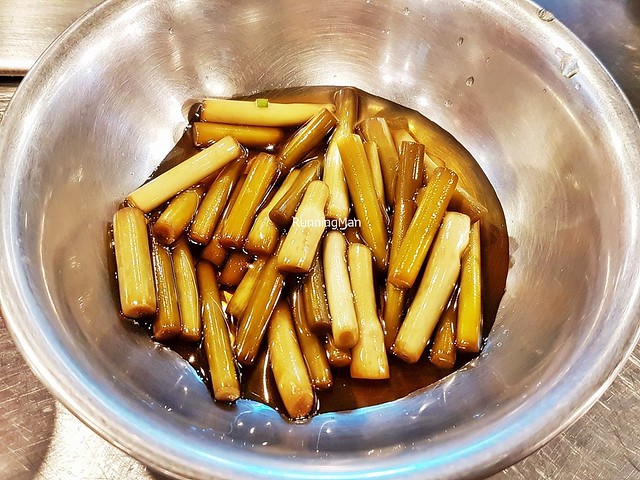 |
| Daepa / Asian Leeks |
Served as a side dish, the Danhobak / Kabocha Squash features cubes of tender, sweet earthy kabocha squash. The delicate flavour serves to provide a balance to heavier flavoured dishes such as grilled seafood or grilled meats.
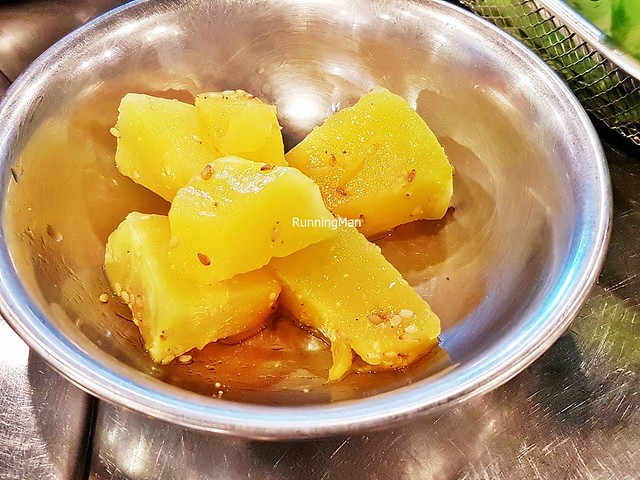 |
| Danhobak / Kabocha Squash |
The Dweji Bulgogi / Pork Bulgogi features sliced pork loin, marinated in a sauce made from white onions, garlic, ginger, green onions, light soy sauce, sugar, black pepper, gochujang / fermented red chili paste, and sesame oil. The stir-fry results in tender pork loin, with a sweet savoury spicy flavour. Usually wrapped in lettuce before being eaten.
 |
| Dweji Bulgogi / Pork Bulgogi |
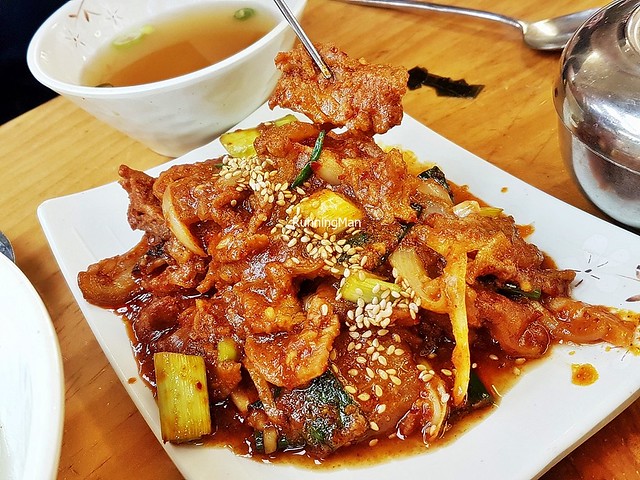 |
| Dweji Bulgogi / Pork Bulgogi |
The Eomuk / Fish Cake is a processed snack made from mashed white fish (cod, pollock, flounder, snapper), sugar, salt, onions, all-purpose flour, sweet potato / potato starch, water, and eggs. It has a bouncy soft texture, with a light savoury sweet flavour. Usually added as an ingredient to other dishes.
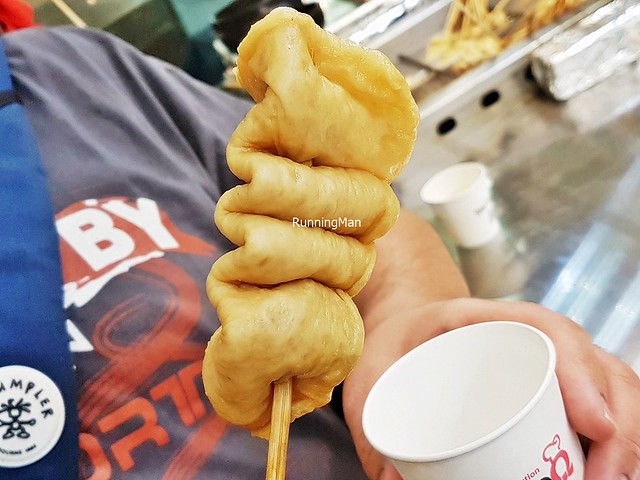 |
| Eomuk / Fish Cake |
 |
| Eomuk Guk / Fish Cake Soup |
 |
| Eomuk Guk / Fish Cake Soup |
 |
| Eomuk / Fish Cake |
 |
| Eomuk / Fish Cake |
 |
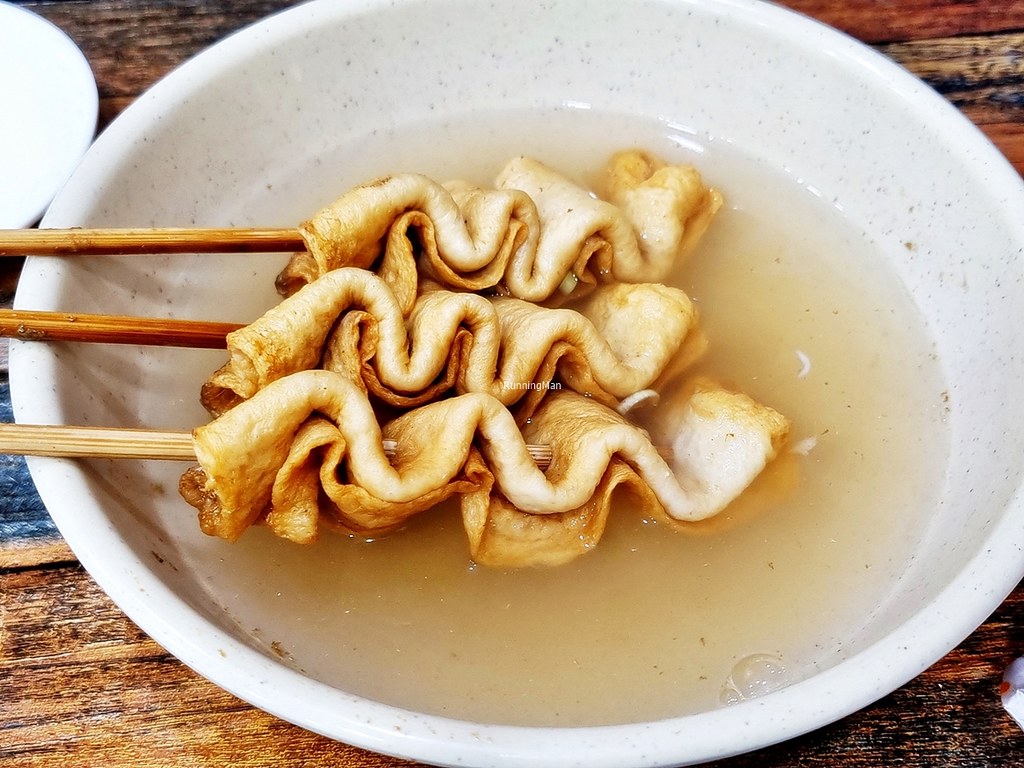 |
 |
| Eomuk / Fish Cake |
The Gogigui / Barbecue is not a dish, but rather a dining experience, aptly named 'Korean Barbecue'. Diners gather around a charcoal grill built into a table, with a ventilation shaft directly overhead, to roast various types of meat. A typical Gogigui / Barbecue is accompanied by Banchan / side dishes, and a dipping sauce such as Gochujang / Fermented Chili Paste.
In Jeju & Seogwipo, the most common and popular meat is black pork. Various cuts are available, such as Teog / Pork Jowl, Samgyeopsal / Pork Belly, and more. All these meats are usually eaten together with Sangchu / Lettuce, where the meat is wrapped within along with gochujang / fermented red chili paste.
The Sangchu / Lettuce lends a gentle refreshing crunch with vegetal sweet flavour. The Samgyeopsal Gui / Grilled Pork Belly is chewy and crunchy, with a good balance of fat to lean pork meat, and carries smoky meaty savoury salty flavour.
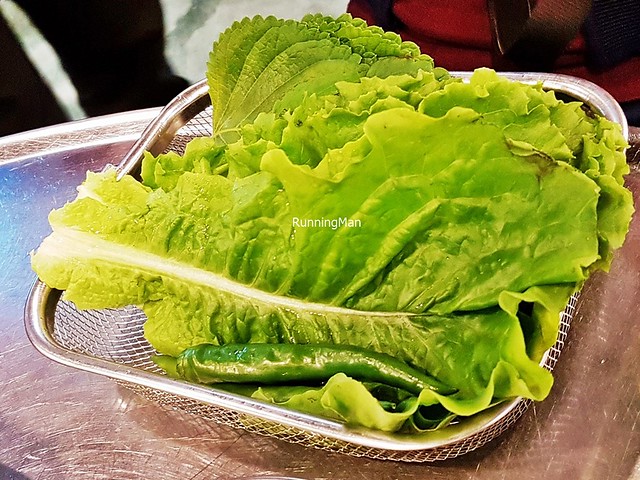 |
| Sangchu / Lettuce |
 |
| Teog / Pork Jowl & Samgyeopsal Gui / Grilled Pork Belly |
 |
| Teog / Pork Jowl & Samgyeopsal Gui / Grilled Pork Belly |
 |
| Teog / Pork Jowl & Samgyeopsal Gui / Grilled Pork Belly |
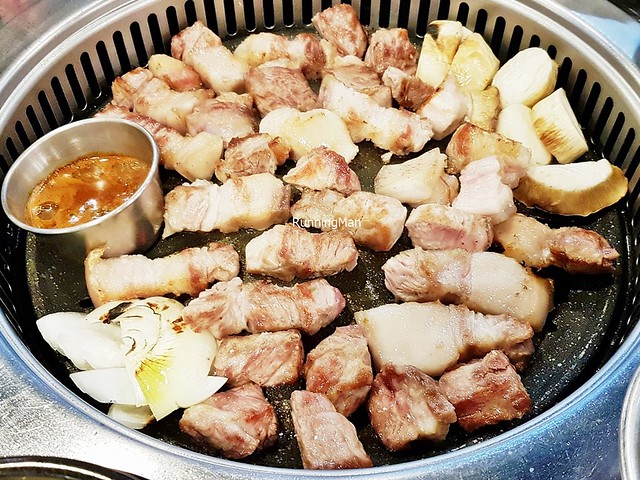 |
| Teog / Pork Jowl & Samgyeopsal Gui / Grilled Pork Belly |
 |
| Sangchu / Lettuce, Put Gochu / Green Chili |
 |
| Sangchu / Lettuce |
 |
| Sangchu / Lettuce |
 |
| Sangchu / Lettuce |
 |
| Sangchu / Lettuce |
 |
| Samgyeopsal Gui / Grilled Pork Belly |
 |
| Samgyeopsal Gui / Grilled Pork Belly |
 |
 |
| Samgyeopsal Gui / Grilled Pork Belly |
 |
 |
| Samgyeopsal Gui / Grilled Pork Belly |
 |
| Samgyeopsal Gui / Grilled Pork Belly |
A traditional dish common to Jeju Special Administrative Province of South Korea, the Gogi-Guksu / Pork Noodles originated due to poor soil conditions for growing white rice. As a result, locals had to adapt to wheat noodles. A culture of giving black pork during happy occasions, coupled with their staple, resulted in this dish. It features long thin wheat noodles with a soft bouncy texture and grainy earthy sweet flavour, garnished with thick slices of tender black pork loin and black pork belly, which is less gamey than regular pork, with a tinge of savoury sweet nutty flavour. Completed with fresh crisp shavings of spring onions, lending vegetal sweet herbal flavour. The hearty, semi-translucent milky soup / broth is made by boiling black pork bones for 12 hours, resulting in a rich delicious bowl. Sometimes garnished with carrots, seaweed, salt, or chili. An iconic, must-eat dish when visiting the island.
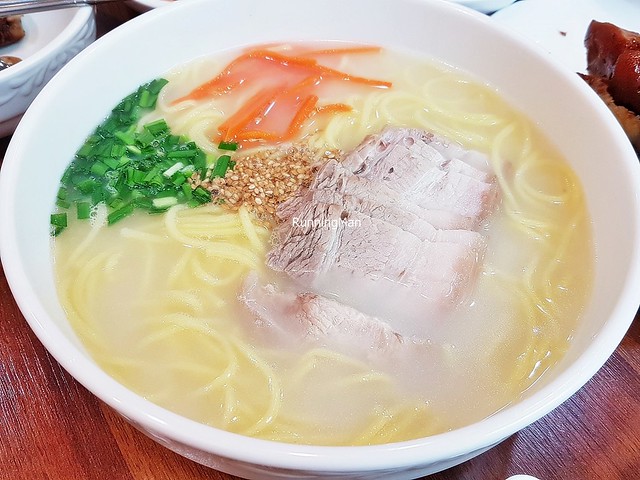 |
| Gogi-Guksu / Pork Noodles |
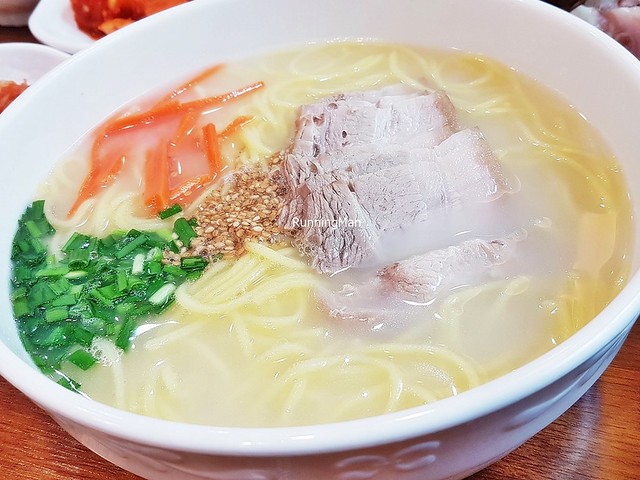 |
| Gogi-Guksu / Pork Noodles |
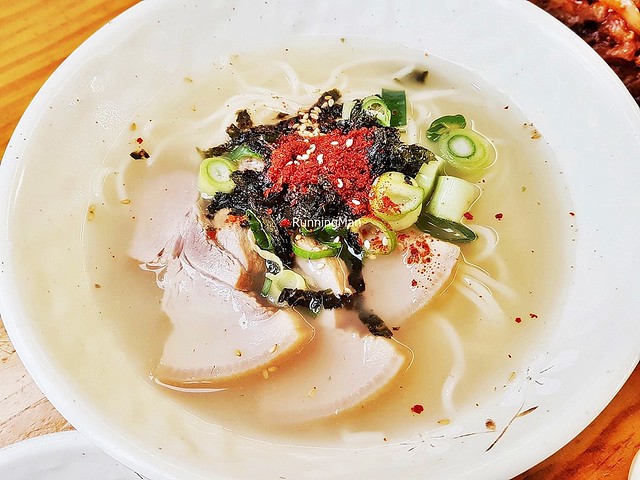 |
| Gogi-Guksu / Pork Noodles |
 |
| Gogi-Guksu / Pork Noodles |
 |
| Gogi-Guksu / Pork Noodles |
 |
| Gogi-Guksu / Pork Noodles |
It may be called Gravel Bread, but it's delicious. This charcoal-infused bun is soft and fluffy, tearing apart easily. Within, a sticky filling of earthy sweet red bean paste and light airy cream, nicely balanced on the palate.
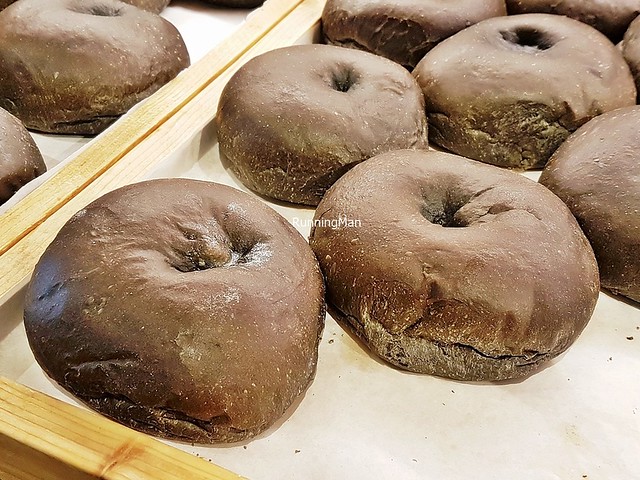 |
| Gravel Bread |
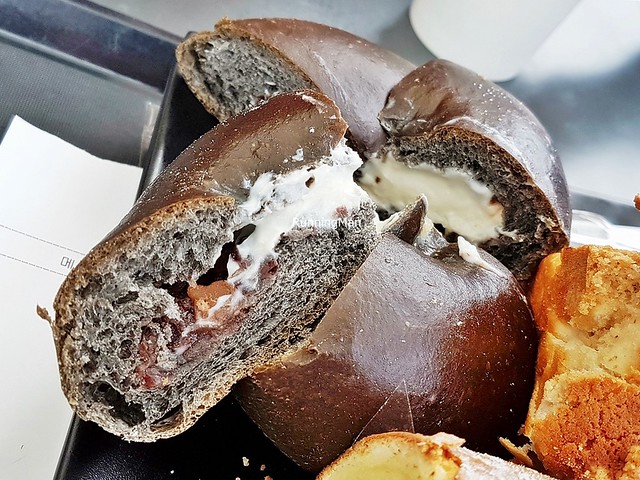 |
| Gravel Bread |
The Godeungeo Gui / Grilled Mackerel Fish in these parts is marginally better than elsewhere, due to its freshness. And because it's readily available, it's also usually cheaper. A whole Spanish mackerel fish, grilled till it takes on a golden brown colour and a smoky aroma. Nice flaky texture to the lean oily fish meat, which comes off the edible bones easily, carrying an addictive smoky savoury salty flavour.
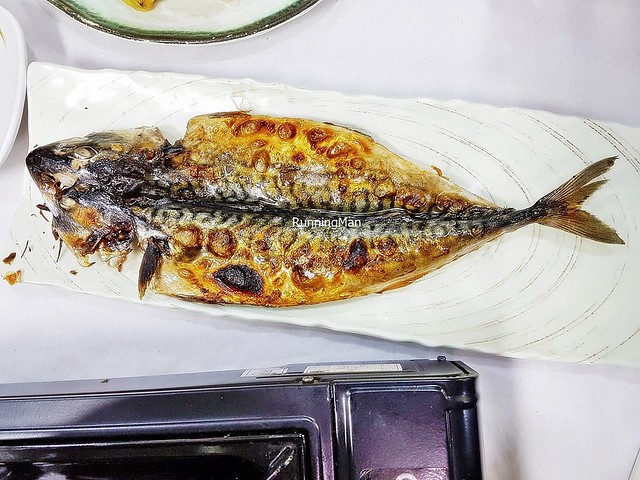 |
| Godeungeo Gui / Grilled Mackerel Fish |
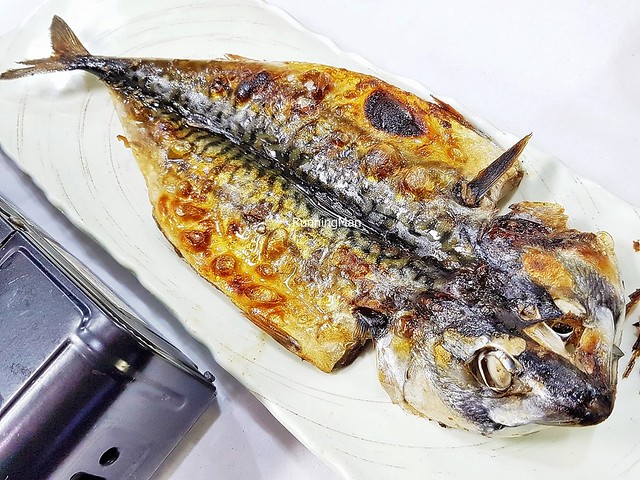 |
| Godeungeo Gui / Grilled Mackerel Fish |
 |
| Godeungeo Gui / Grilled Mackerel Fish |
 |
| Godeungeo Gui / Grilled Mackerel Fish |
 |
| Godeungeo Gui / Grilled Mackerel Fish |
 |
| Godeungeo Gui / Grilled Mackerel Fish |
 |
| Godeungeo Gui / Grilled Mackerel Fish |
Among the more exotic dishes on the island is Horse Meat Hot Plate. Cubes of farmed horse meat, with a tender chewy texture similar to beef, is grilled to a medium doneness. Seasoned with salt and yellow mustard, it has a delicate savoury salty flavour, less gamey than beef. The tangy sauce helps to balance the meaty taste on the palate.
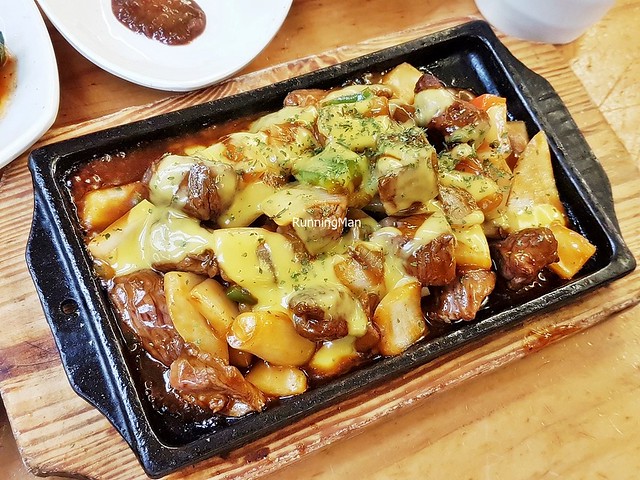 |
| Horse Meat Hot Plate |
 |
| Horse Meat Hot Plate |
 |
| Horse Meat Hot Plate |
 |
| Horse Meat Hot Plate |
The Jeonbok Juk / Abalone Porridge is popular amongst tourists, because the luxury ingredient of abalone is more abundant and affordable here. The abalone is slow boiled, with white rice, water, and light soy sauce; until it turns tender and chewy, its essence infusing the porridge, with the finished dish garnished with dried seaweed and sesame seeds. It has a semi-thick, sticky gloopy texture, with a delicate sweet savoury salty earthy flavour. I personally like to add condiments for better taste.
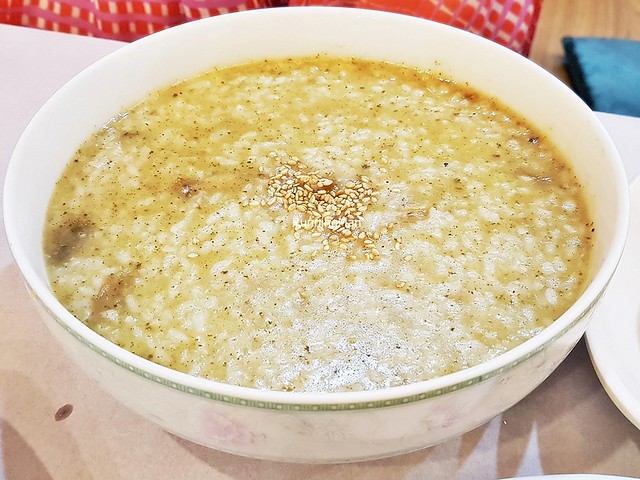 |
| Jeonbok Juk / Abalone Porridge |
 |
| Jeonbok Juk / Abalone Porridge |
 |
| Jeonbok Juk / Abalone Porridge |
 |
| Jeonbok Juk / Abalone Porridge |
 |
| Jeonbok Juk / Abalone Porridge |
Considered among the world's healthiest foods, and said to even prevent stomach cancer, Kimchi Baechu / Kimchi Pickled Cabbage is more than just a tasty Banchan / side dish, but is also a versatile ingredient incorporated into many Korean dishes. It's made with napa cabbage rubbed with sea salt; seasoned with a paste made from scallions, ginger, daikon radish, garlic, glutinous rice, saeujeot / fermented shrimp sauce, aekjeot / fish sauce, eoriguljeot / oyster sauce, and chili; then left to ferment in a brine of white vinegar and water. The most iconic national dish of South Korea, this is commonly served at every meal in Jeju & Seogwipo, and has a sharp vegetal sour sweet spicy taste, with a crisp juicy texture.
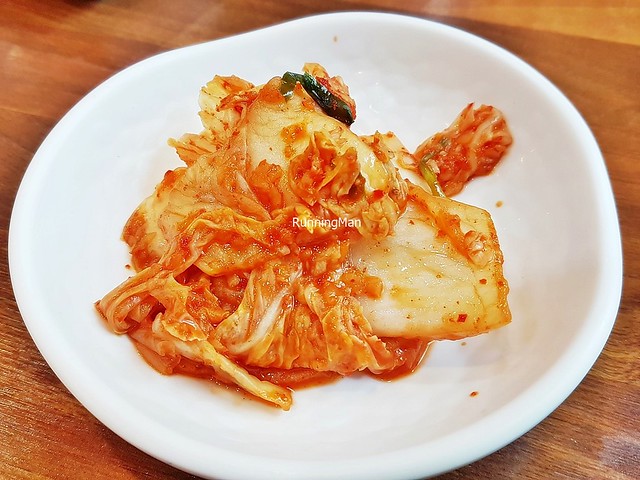 |
| Kimchi Baechu / Kimchi Pickled Cabbage |
 |
| Kimchi Baechu / Kimchi Pickled Cabbage |
 |
 |
 |
| Kimchi Baechu / Kimchi Pickled Cabbage |
 |
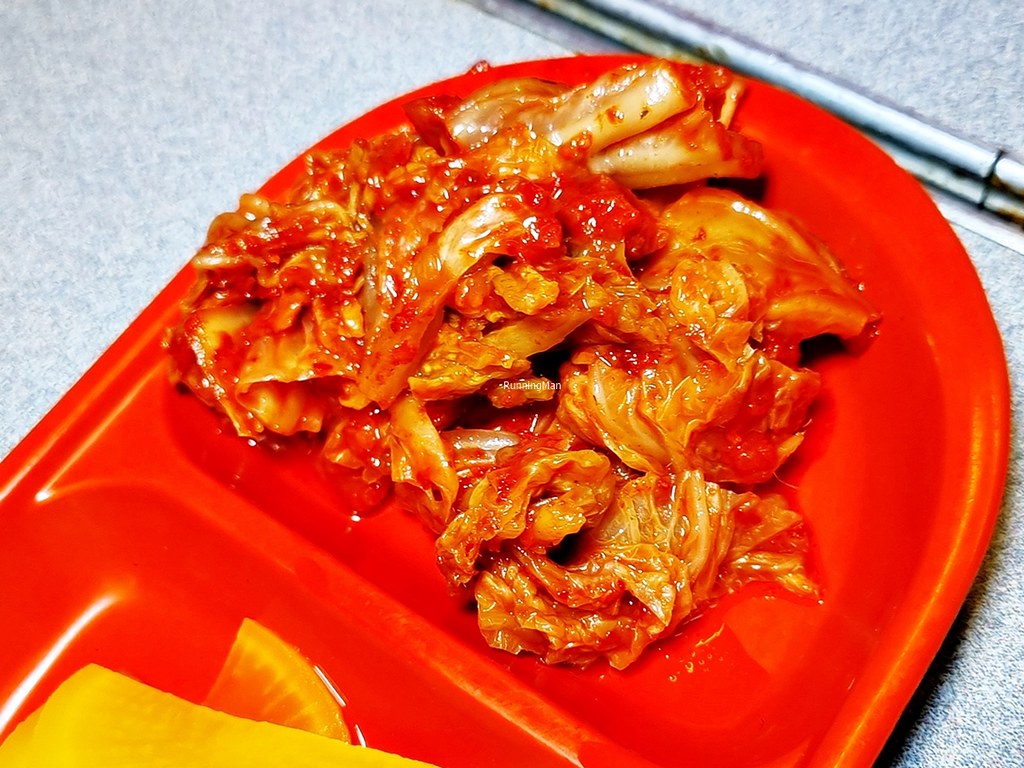 |
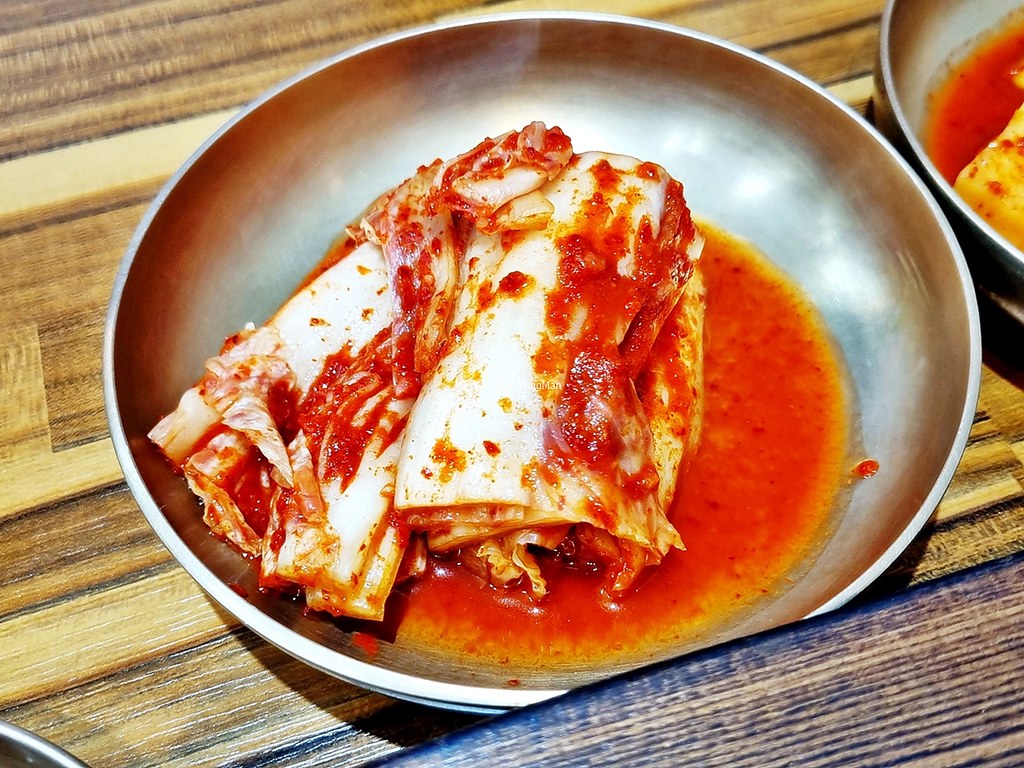 |
 |
| Kimchi Baechu / Kimchi Pickled Cabbage |
Trailing just behind in popularity is another variation of Kimchi, the Kimchi Oi Sobaegi / Kimchi Pickled Cucumber, also served as a Banchan / side dish. While essentially all the same seasonings, ingredients, and preparation methods are used, this simply replaces the napa cabbage with cucumbers instead. It has that same sharp vegetal sour sweet spicy taste, with a crunchy juicy texture.
 |
| Kimchi Oi Sobaegi / Kimchi Pickled Cucumber |
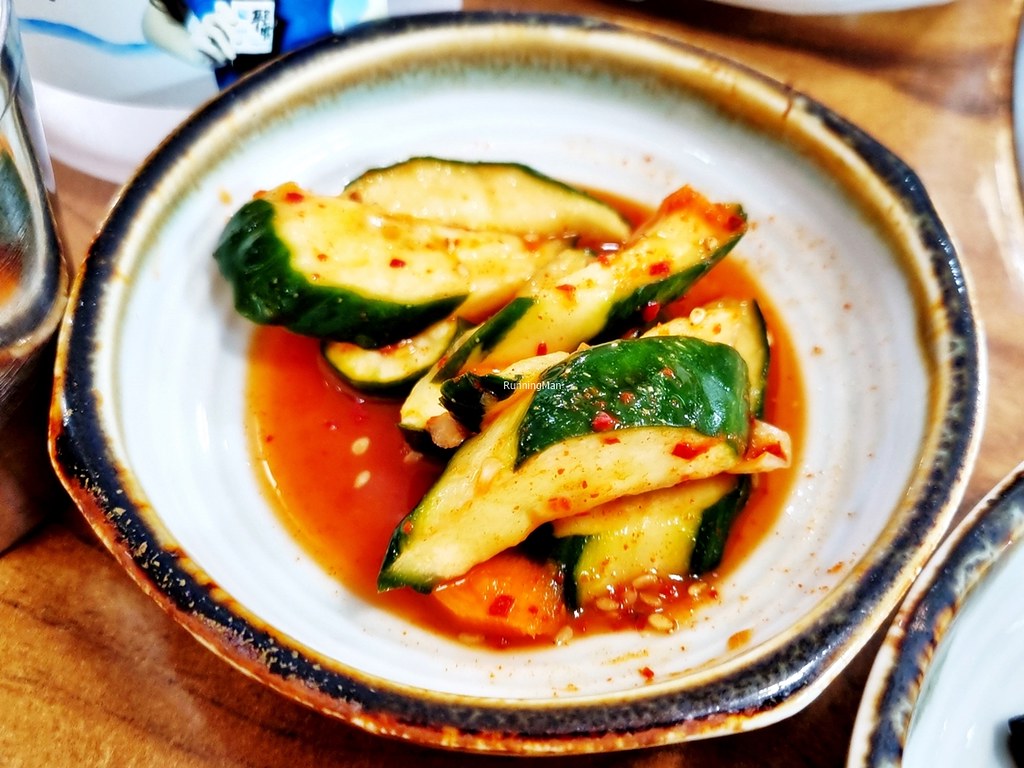 |
| Kimchi Oi Sobaegi / Kimchi Pickled Cucumber |
The Kimchi Kkakdugi / Kimchi Pickled Daikon Radish is a banchan / side dish that is typically consumed chilled, and has a sharp sour sweet spicy vegetal flavour with a firm juicy crunch to texture. It uses the same seasonings as other Kimchi items. Timing is more critical with the daikon radish, as it has to be eaten before it goes soft.
 |
| Kimchi Kkakdugi / Kimchi Pickled Daikon Radish |
 |
| Kimchi Kkakdugi / Kimchi Pickled Daikon Radish |
 |
| Kimchi Kkakdugi / Kimchi Pickled Daikon Radish |
 |
| Kimchi Kkakdugi / Kimchi Pickled Daikon Radish |
Another common Banchan / side dish, the Kongnamul / Cold Soy Bean Sprouts is a refreshing dish served chilled, featuring crunchy crisp soy bean sprouts boiled with salt, garlic, aekjeot / fish sauce, then garnished with sesame seeds. Has a vegetal earthy sweet nutty flavour. Sometimes, chili is added. This is eaten along with white rice.
 |
| Kongnamul / Cold Soy Bean Sprouts |
 |
| Kongnamul / Cold Soy Bean Sprouts |
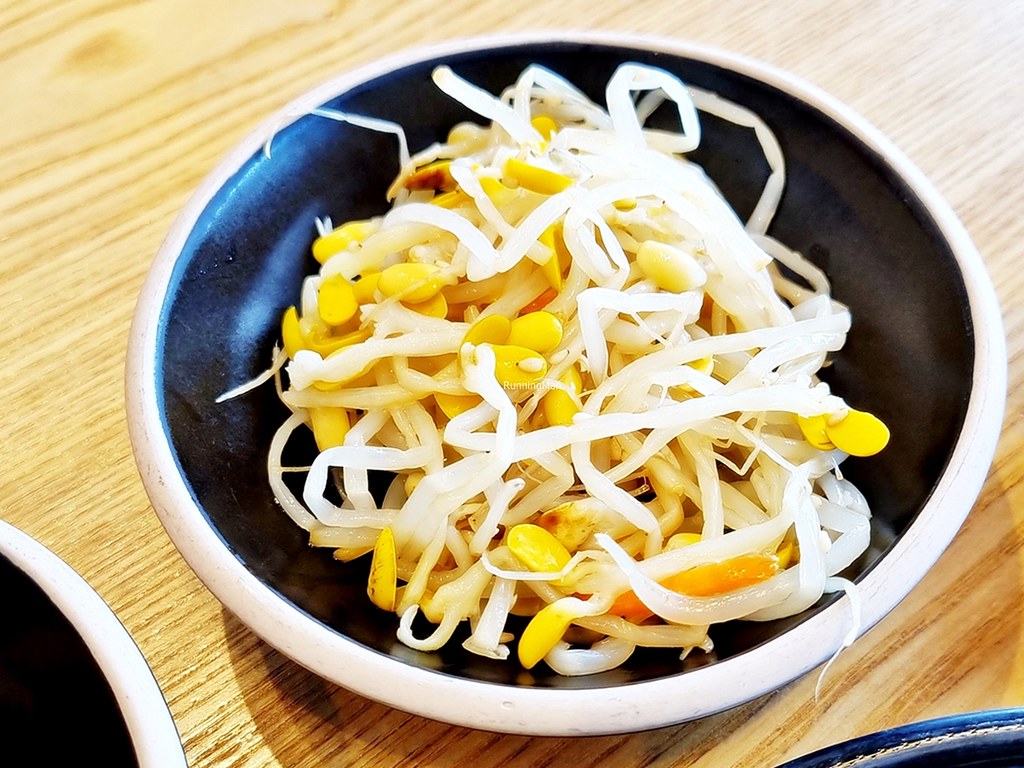 |
| Kongnamul / Cold Soy Bean Sprouts |
 |
| Kongnamul / Cold Soy Bean Sprouts |
The Korean Coleslaw features a mix of purple and white cabbage, shredded and coated with mayonnaise. Has a nice freshness, with a crunchy texture, and a light vegetal sweet flavour.
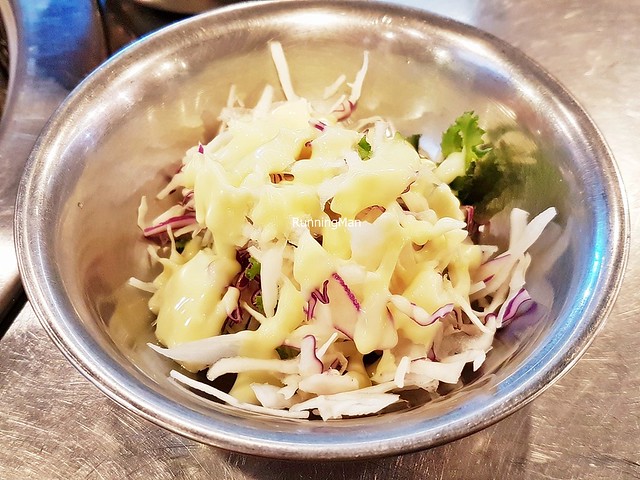 |
| Korean Coleslaw |
As the oldest liquor in the country, Makgeolli / Rice Wine, also known as Nongju, is a drink favoured by the working-person. Made from nothing more than fermented white rice, yeast, and water, this milky, semi-sweet, slightly fizzy alcoholic beverage is surprisingly healthy, with up to 10% composed of lactic acid bacteria and dietary fiber. This unfiltered rice wine has an almost universal appeal, from both genders, youth to elderly, and even celebrities.
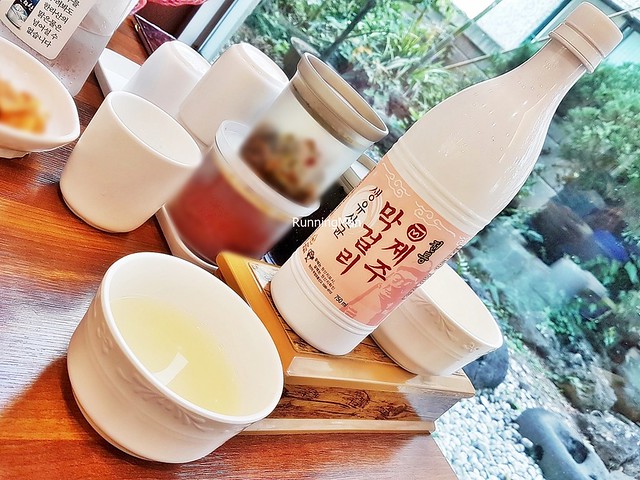 |
| Makgeolli / Rice Wine |
 |
| Makgeolli / Rice Wine |
 |
| Makgeolli / Rice Wine |
 |
| Makgeolli / Rice Wine |
 |
| Makgeolli / Rice Wine |
The Mandu / Dumpling is a common main dish / snack, and are usually filled with either minced meat (pork, beef), tofu beancurd, spinach, shiitake mushrooms, Kimchi Baechu / Kimchi Pickled Cabbage, scallions, or a combination of these ingredients. It can be boiled or steamed, grilled or fried, served dry or in a soup / broth. Has a tender soft juicy texture with robust meaty vegetal sweet savoury salty earthy flavour. If served in a soup / broth, the dish is called Manduguk, and usually features either a beef stock or anchovy stock, along with egg and seaweed. The most common versions include Mul Mandu / Boiled Pork Dumplings, Jjin Mandu / Steamed Pork Dumplings, and Kimchi Mandu / Steamed Kimchi Pork Dumplings.
 |
| Mandu / Dumpling |
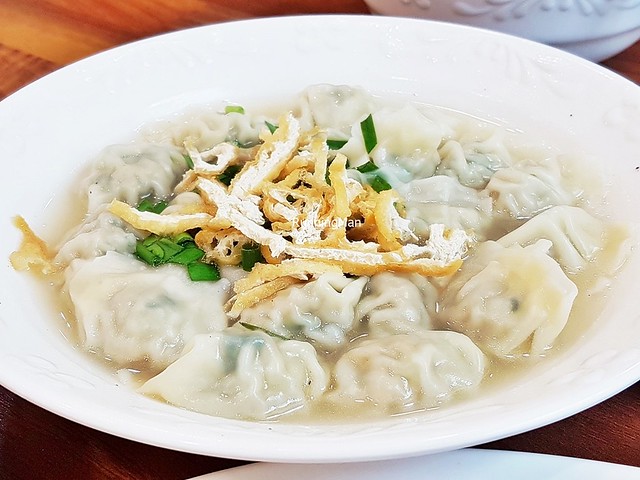 |
| Mandu / Dumpling |
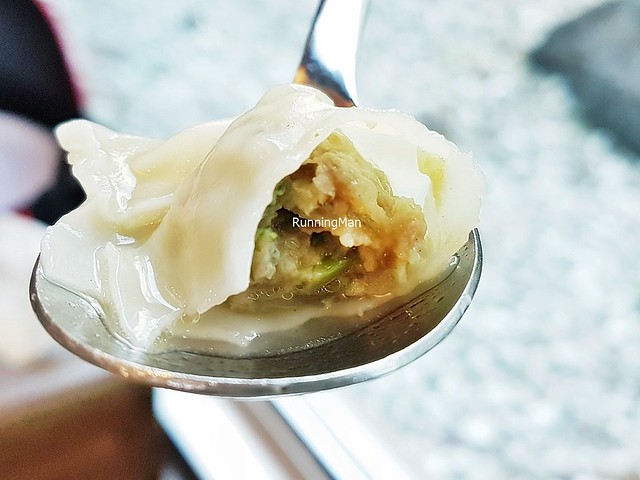 |
 |
 |
| Mandu / Dumpling |
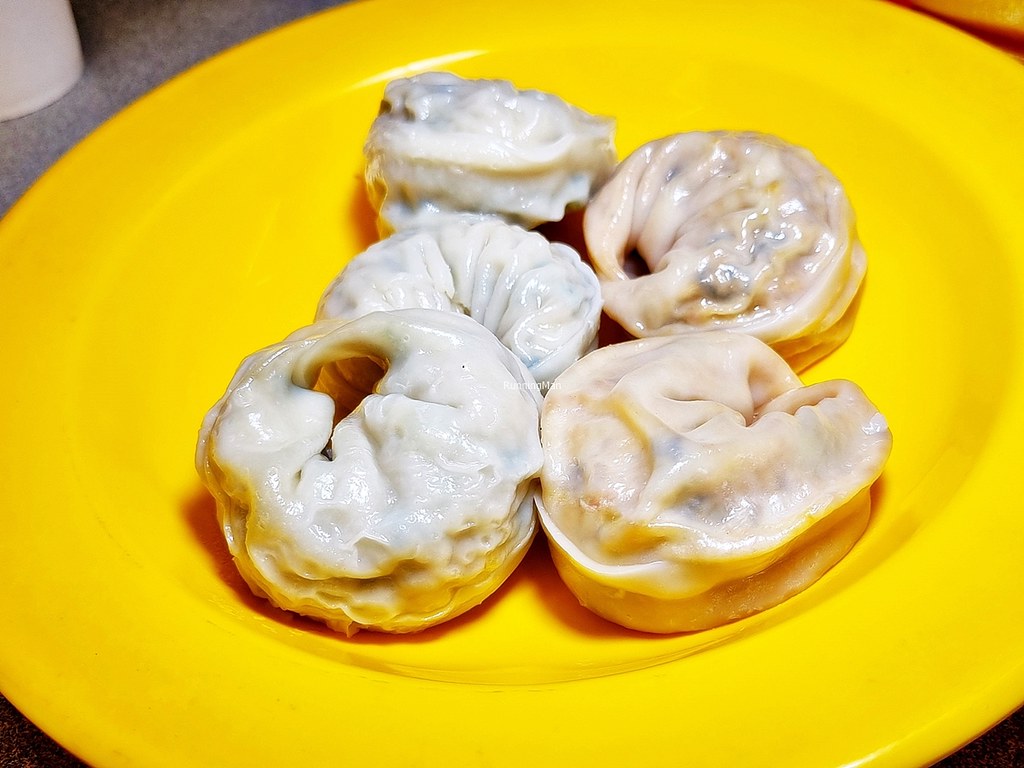 |
| Mandu / Dumpling |
 |
| Mul Mandu / Boiled Pork Dumplings |
 |
| Mul Mandu / Boiled Pork Dumplings |
 |
| Jjin Mandu / Steamed Pork Dumplings |
 |
| Jjin Mandu / Steamed Pork Dumplings |
 |
| Kimchi Mandu / Steamed Kimchi Pork Dumplings |
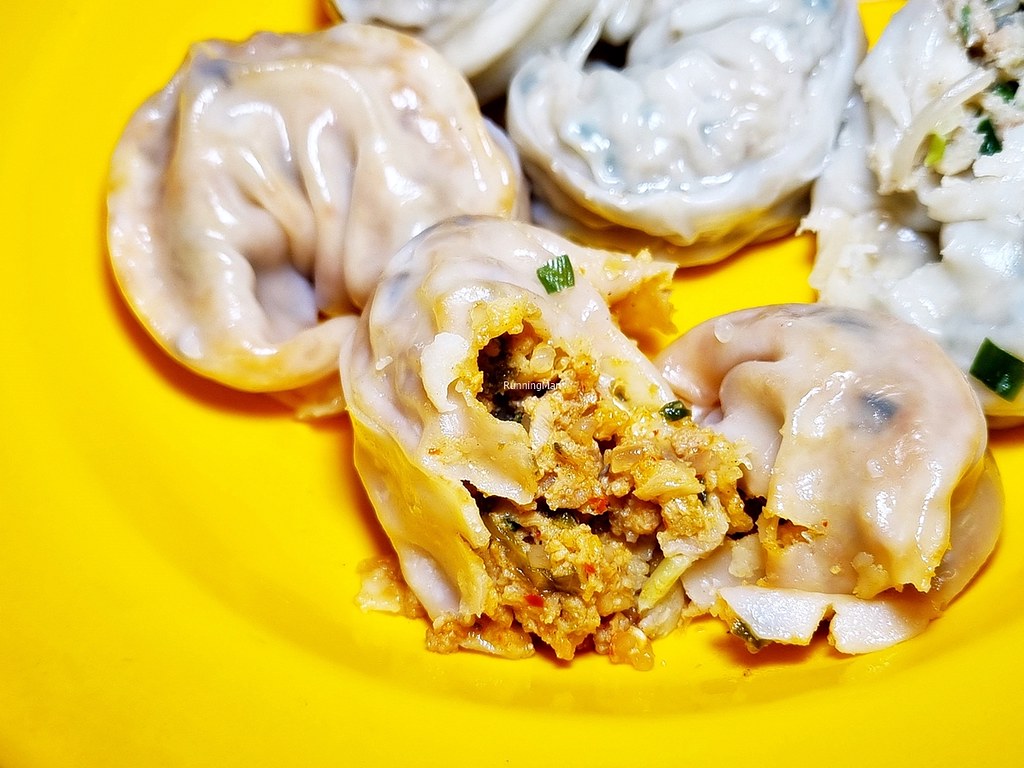 |
| Kimchi Mandu / Steamed Kimchi Pork Dumplings |
The Malcha Nok Cha Aiseukeulim / Matcha Green Tea Ice Cream contains premium matcha green tea powder and milk, sourced from local farms. Has a rich, creamy smooth texture, with intense earthy vegetal sweet milky flavours of green tea. Among the best versions I've tasted.
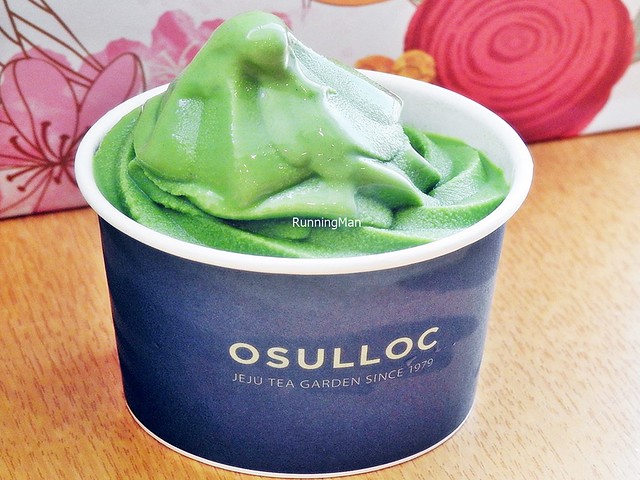 |
| Malcha Nok Cha Aiseukeulim / Matcha Green Tea Ice Cream |
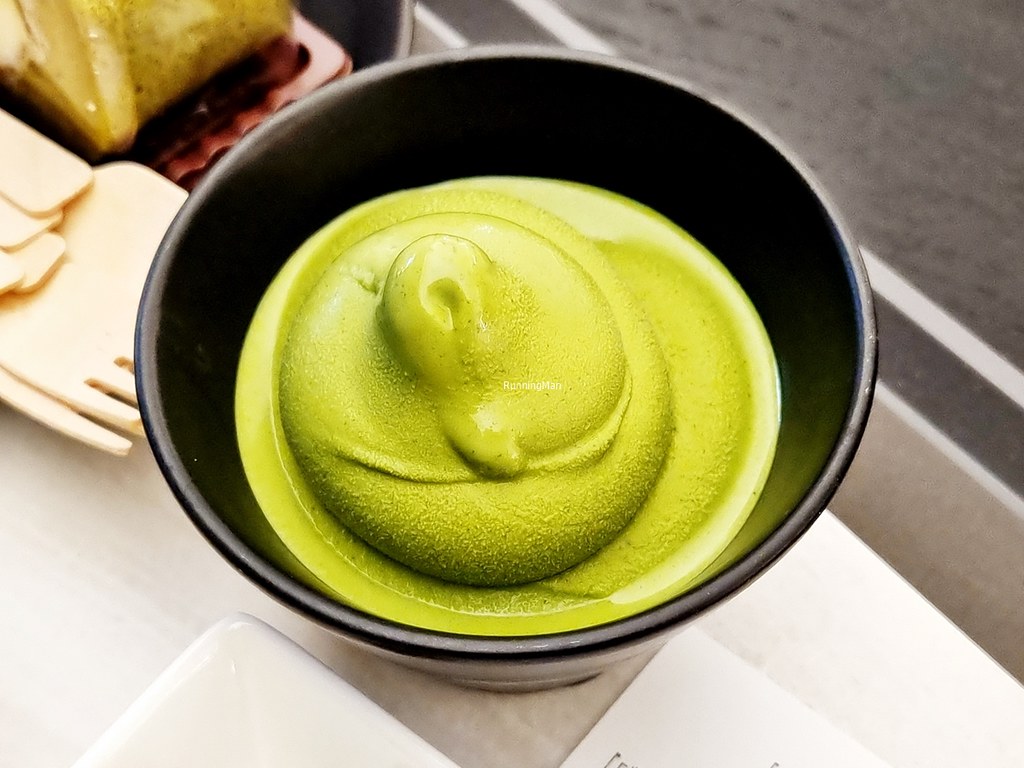 |
| Malcha Nok Cha Aiseukeulim / Matcha Green Tea Ice Cream |
The Malcha Nok Cha Keikeu / Matcha Green Tea Roll Cake has a fluffy soft green tea sponge cake, infused with premium matcha green tea powder. The center filling is a rich smooth cream of full cream milk and sugar, resulting in a light earthy sweet grassy flavour. Well balanced dessert confectionery, very nice.
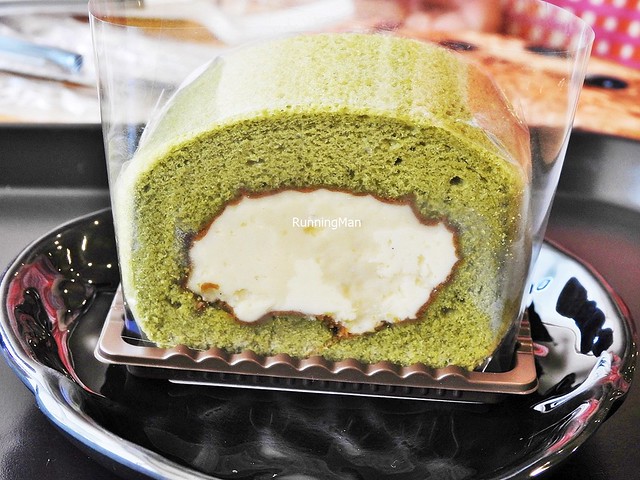 |
| Malcha Nok Cha Keikeu / Matcha Green Tea Roll Cake |
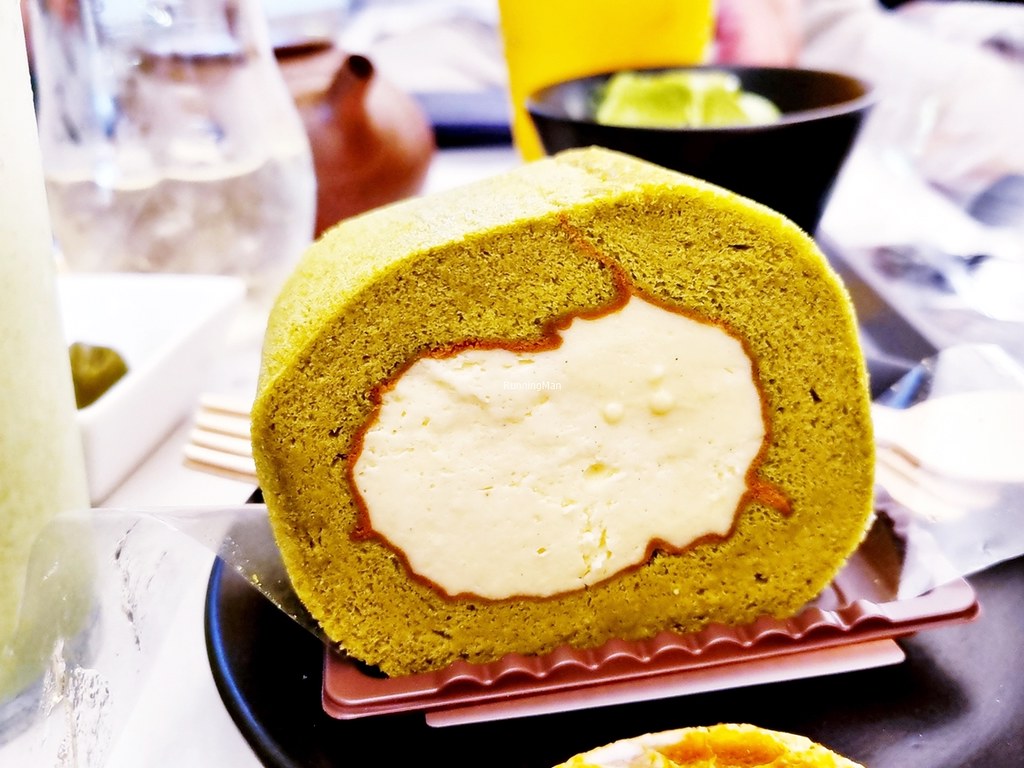 |
| Malcha Nok Cha Keikeu / Matcha Green Tea Roll Cake |
 |
| Malcha Nok Cha Keikeu / Matcha Green Tea Roll Cake |
The Milk Roll Cake is a simple dessert confectionery, with a airy soft milk sponge cake, filled with a rich, smooth cream of full cream milk and sugar. Nicely sweet but not overwhelming, it's light on the palate. Tasty!
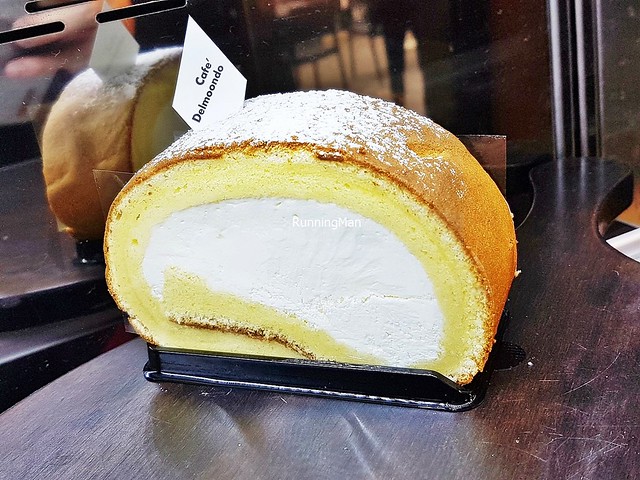 |
| Milk Roll Cake |
The Mul-Naengmyeon / Cold Noodles Soup is a common dish in Jeju & Seogwipo, owing to the strong noodle culture here. It features a rich, robust, chilled soup / broth of either pork bones or beef bones, consisting of long thin wheat noodles, cucumbers, boiled egg, sliced Korean pear, Kimchi Kkakdugi / Kimchi Cubed Pickled Daikon Radish, white vinegar, ginger, and garlic. It differs from the mainland version in 2 areas, the soup / broth, and the noodles.
 |
| Mul-Naengmyeon / Cold Noodles Soup |
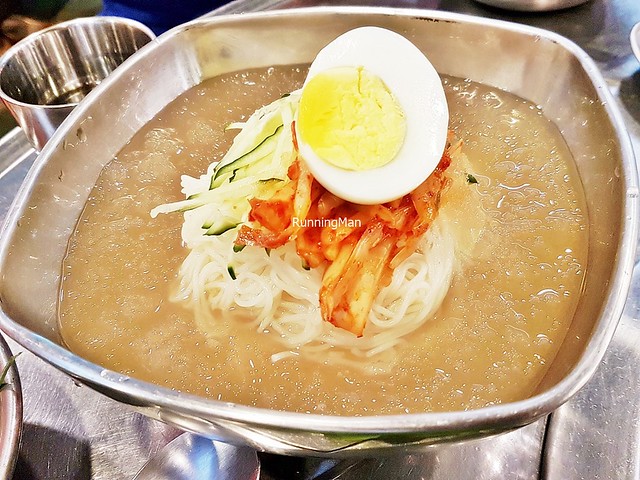 |
| Mul-Naengmyeon / Cold Noodles Soup |
The Myeolchi Bokkeum / Fried Anchovies is a common side dish, made from dried anchovy fish, sugar, salt, garlic, and sesame oil, with some variations also adding gochujang / fermented red chili paste. It has a satisfiying crispy crunchy texture, with flavours of savoury, salty, sweet, fishy, and may be mildly spicy.
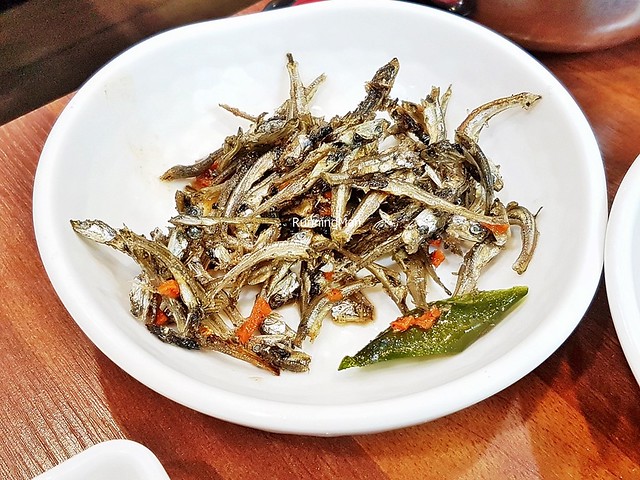 |
| Myeolchi Bokkeum / Fried Anchovies |
 |
| Myeolchi Bokkeum / Fried Anchovies |
 |
| Myeolchi Bokkeum / Fried Anchovies |
The Octopus Live has a live baby octopus, sliced up and served raw, marinated in lemon juice. Really fresh, the method of preparation causes the parts to wriggle around on the plate. The texture is more bouncy firm than the regular cooked octopus, but it still has a delicate sweet savoury flavour, very clean-tasting.
 |
| Octopus Live |
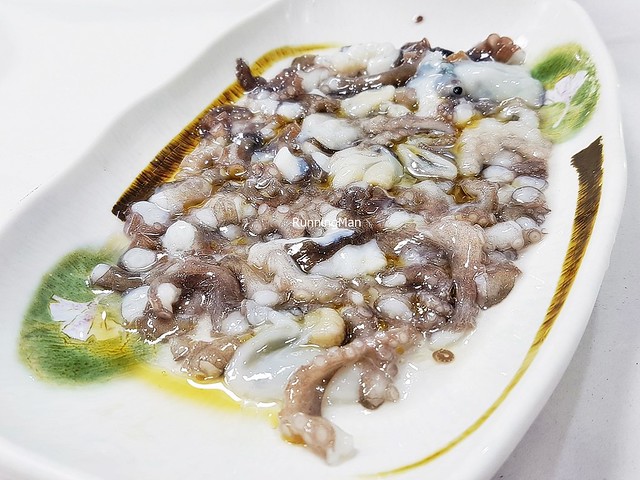 |
| Octopus Live |
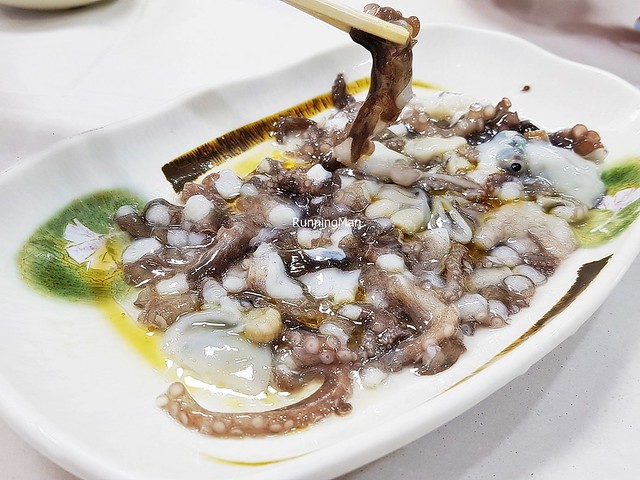 |
| Octopus Live |
The Pa Muchim / Green Onion Salad is usually served as a side dish, to accompany barbecued meats. It features julienned green onions, simply dressed in sesame oil and gochujang / fermented red chili paste. More elaborate versions sometimes include sugar, light soy sauce, white vinegar, and sesame seeds. Nice crisp crunchy texture with a bright vegetal sweet spice flavour. I prefer mine with more spicy gochujang / fermented red chili paste.
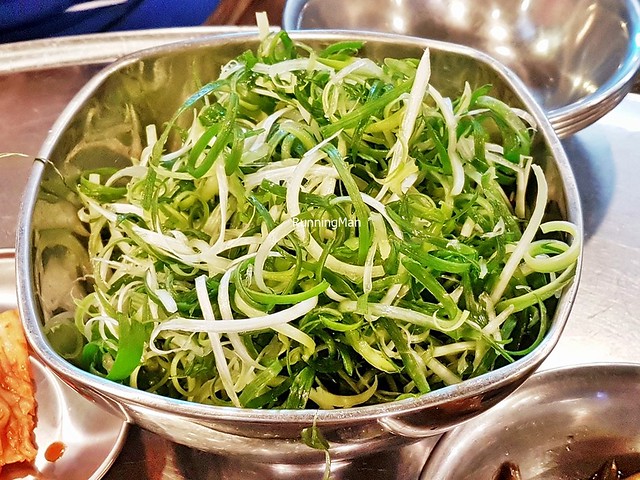 |
| Pa Muchim / Green Onion Salad |
 |
| Pa Muchim / Green Onion Salad |
 |
| Pa Muchim / Green Onion Salad |
 |
| Pa Muchim / Green Onion Salad |
The Korean term Saengseon-Hoe refers to a variety platter of raw seafood dishes, similar to the Japanese sashimi, usually eaten in a group / communal fashion. Here, it's a local speciality, as the area is known for its fresh seafood. Catch combination usually differs from season to season, but normally includes several types of white fish, prawns / shrimp, squid or octopus, and shellfish.
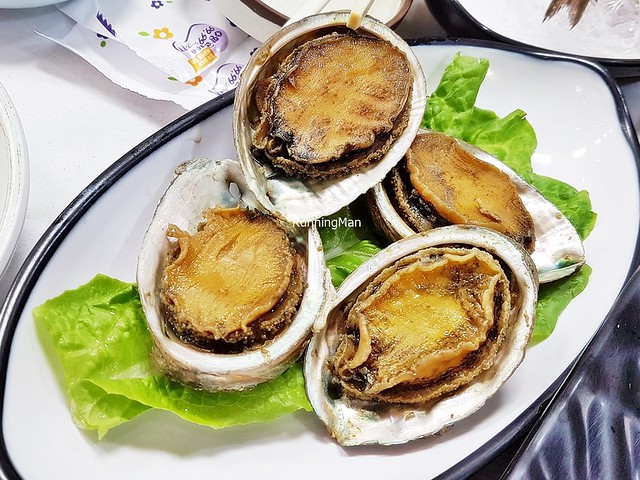 |
| Saengseon-Hoe - Abalone |
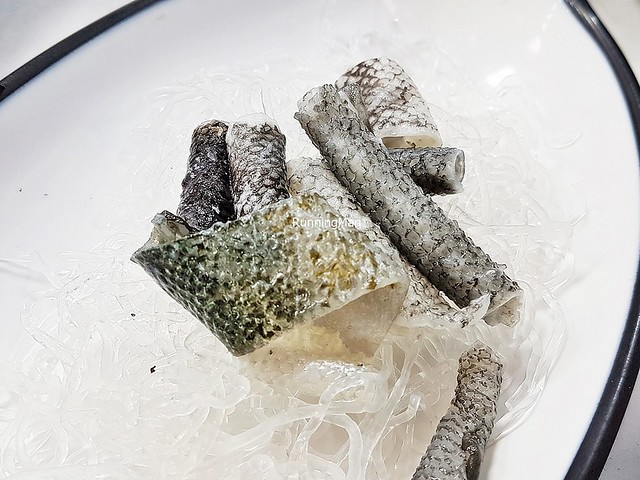 |
| Saengseon-Hoe - Carp Skin |
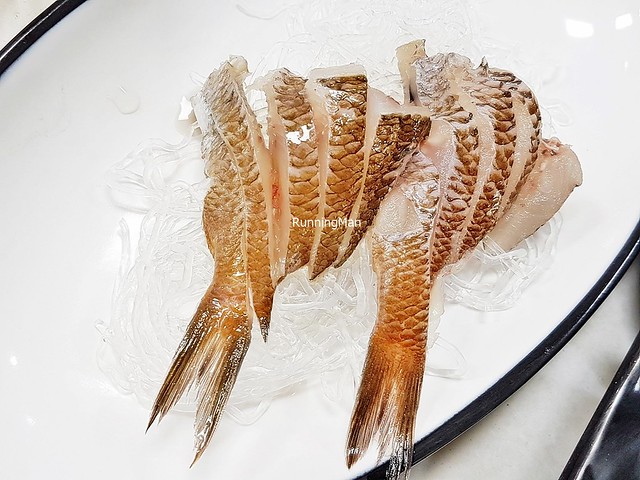 |
| Saengseon-Hoe - Ilisha Elongata |
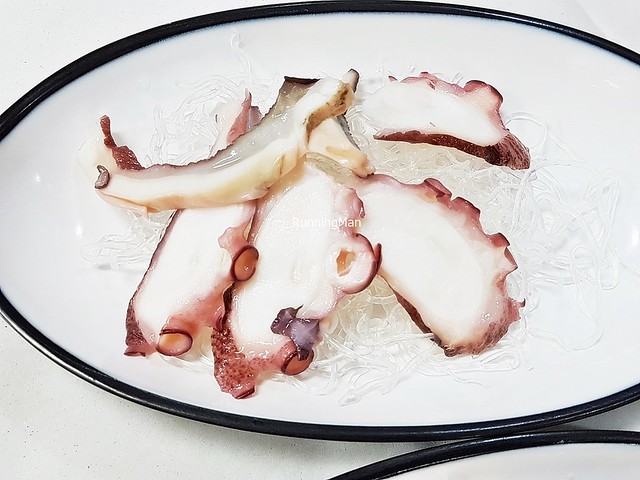 |
| Saengseon-Hoe - Octopus |
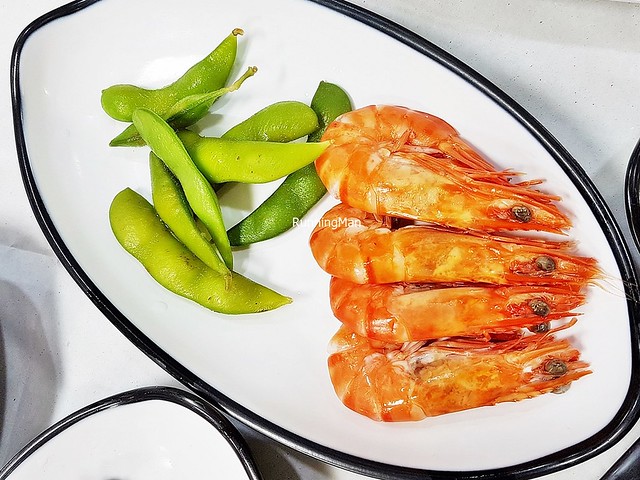 |
| Saengseon-Hoe - Prawns, Sugar Snap Peas |
 |
| Saengseon-Hoe - Sandfish |
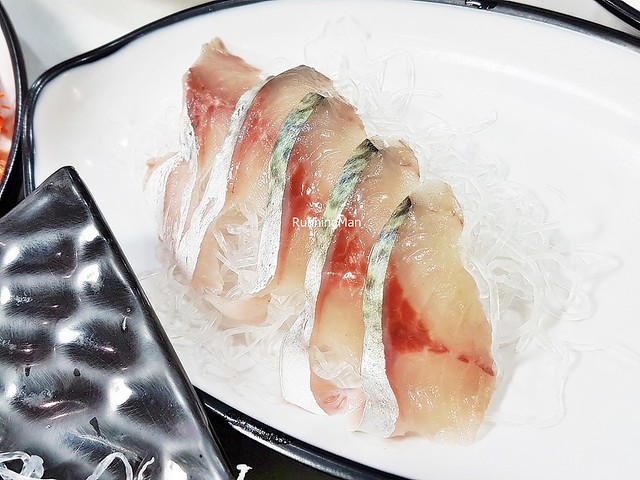 |
| Saengseon-Hoe - Horse Mackerel |
 |
| Saengseon-Hoe - Snakehead |
The Saengseon-Hoe - Cutlassfish / Largehead Hairtail here is outstanding. When served raw, the fish has a bouncy soft texture, and a beautiful silver shine to the skin. Delicate sweet savoury flavour, very clean-tasting and fresh.
 |
| Saengseon-Hoe - Cutlassfish / Largehead Hairtail |
The Saengseon-Hoe - Sea Bream here is outstanding, possibly among the world's best. When served raw, the fish has a tender bouncy texture, with a nice chew. Delicate sweet flavour, very clean-tasting and fresh, completely enticing.
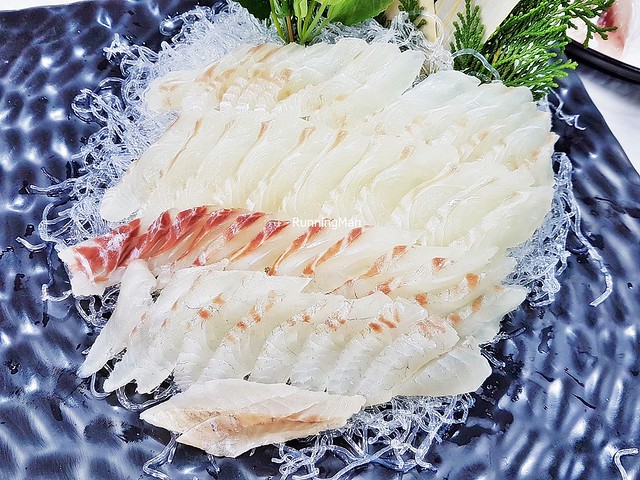 |
| Saengseon-Hoe - Sea Bream |
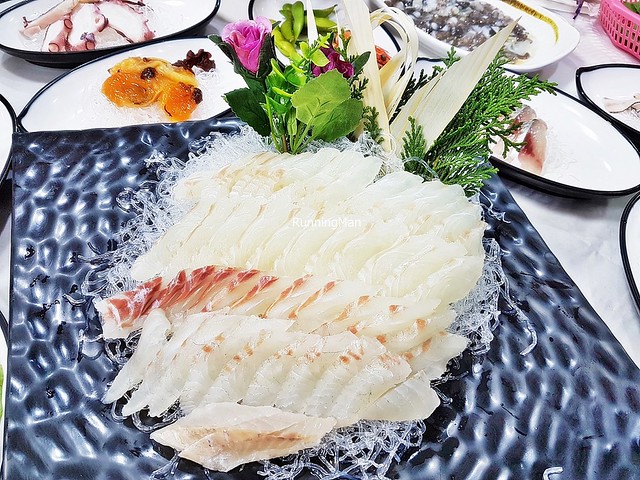 |
| Saengseon-Hoe - Sea Bream |
A unique dish with an other-worldly appearance, the Saengseon-Hoe - Sea Squirt consists of raw sea pineapple / sea squirt, eaten together with a mix of white vinegar and light soy sauce. It has a firm bouncy texture, akin to rubber, with a peculiar taste, earthy briny salty chemical-like, similar to iodine. Among the more exotic dishes on the island.
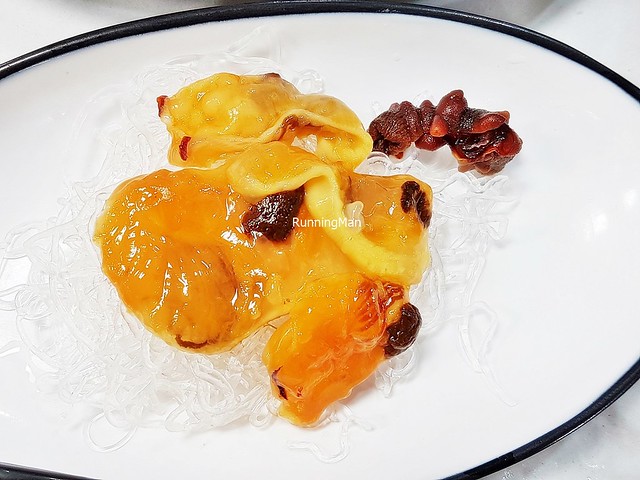 |
| Saengseon-Hoe - Sea Squirt |
The Samdayeon Tangerine Tea is a blended tea, a mix of premium green tea leaves and tangerine, all grown in local farms. The blend is post-fermented in cedar wood, and has a bright, clean feeling, with a fruity earthy sweet flavour.
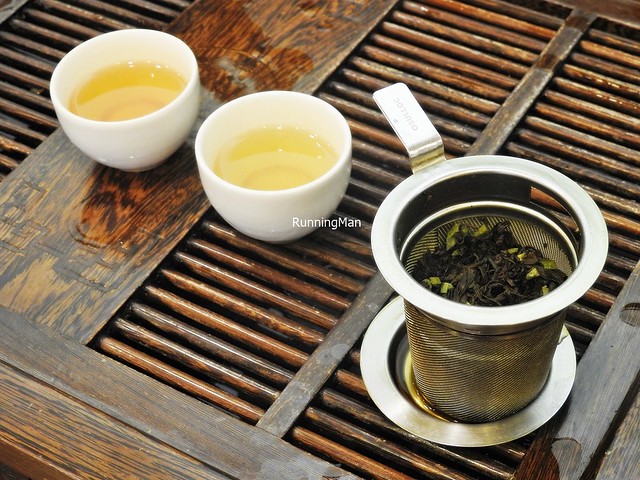 |
| Samdayeon Tangerine Tea |
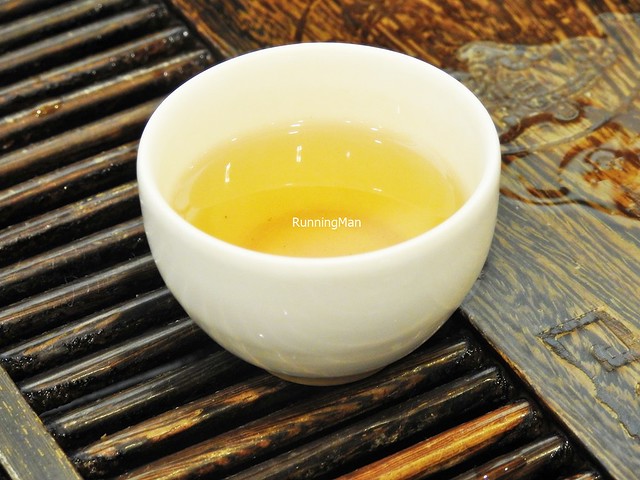 |
| Samdayeon Tangerine Tea |
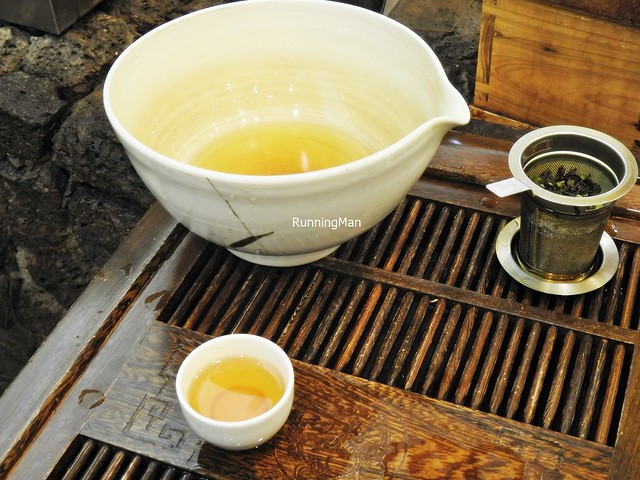 |
| Samdayeon Tangerine Tea |
A bowl of Ssalbap / Steamed White Rice typically accompanies any meal in Jeju & Seogwipo, South Korea. The texture is sticky but not clumpy, with a light fragrant aroma, and grainy sweet flavour. Some variations may include a dressing of foxtail millet or dried shredded seaweed.
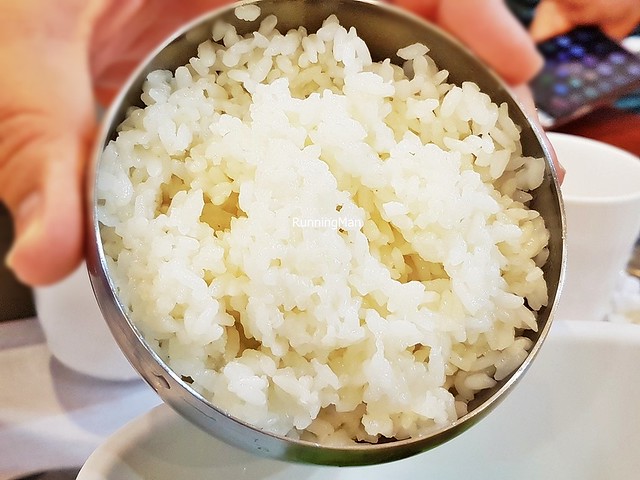 |
| Ssalbap / Steamed White Rice |
 |
| Ssalbap / Steamed White Rice |
 |
| Ssalbap / Steamed White Rice |
 |
| Ssalbap / Steamed White Rice |
The Tteokbokki / Ddukbokki / Rice Cakes is a common and popular Banchan / side dish, also often sold along the streets as a snack. Made by boiling then stir-frying Tteok / Dduk / rice cakes, which are soft, chewy, but tasteless, glutinous rice cake shaped like round tubes, in a sweet, savoury, spicy gravy of water and gochujang / fermented red chili paste, along with eomuk / fish cakes, onions, salt, sugar, garlic, and scallions. Sometimes, pork or eggs are added. Tteokbokki / Ddukbokki / Rice Cakes is sometimes used as a base ingredient, and incorporated into other Korean main dishes. There are also many variations of it available.
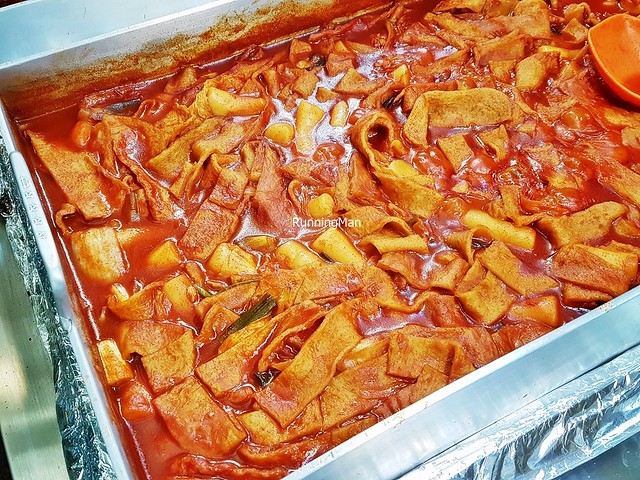 |
| Tteokbokki / Ddukbokki / Rice Cakes |
 |
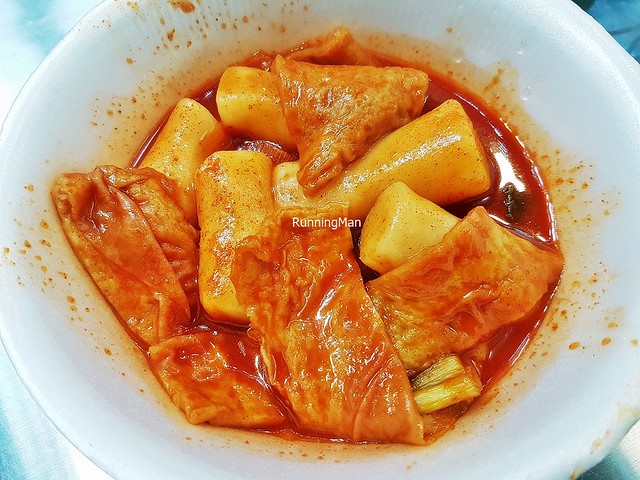 |
 |
| Tteokbokki / Ddukbokki / Rice Cakes |
 |
| Tteokbokki / Ddukbokki / Rice Cakes |
 |
 |
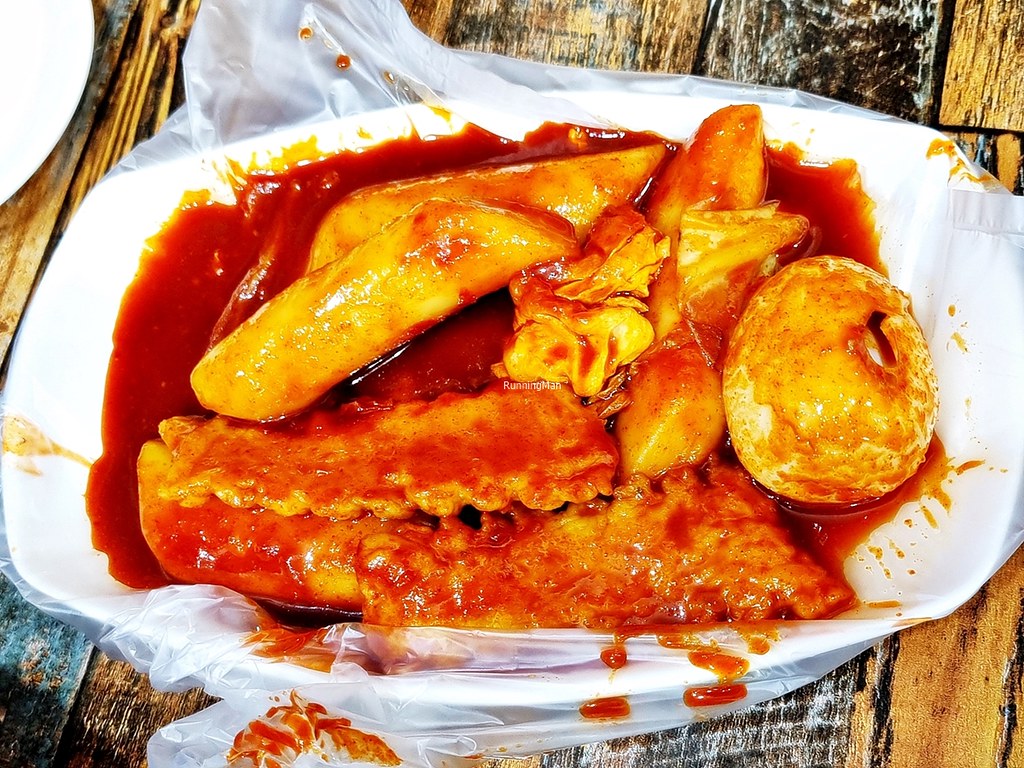 |
| Tteokbokki / Ddukbokki / Rice Cakes |
The Ttukbaegi Gyeran Jjim / Steamed Egg In Pot is a simple but comforting Banchan / side dish, consisting of whisked chicken eggs seasoned with garlic, aekjeot / fish sauce, chicken stock, water, and sesame oil, then steamed till soft and fluffy in an earthenware pot, garnished with scallions. Love the light eggy savoury salty sweet flavour, which pairs well with the more heavily seasoned main dishes.
 |
| Ttukbaegi Gyeran Jjim / Steamed Egg In Pot |
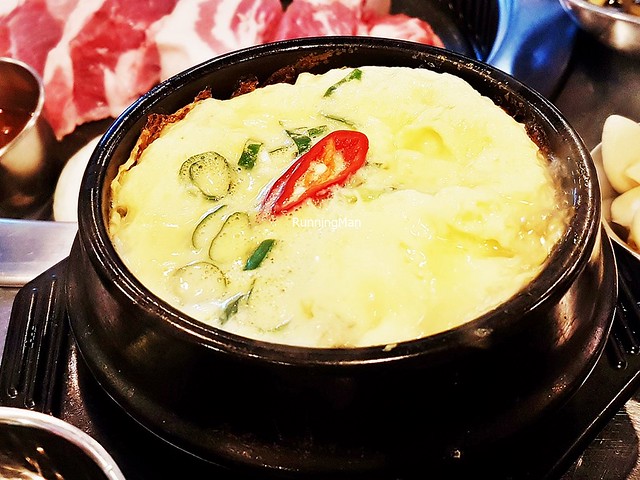 |
 |
| Ttukbaegi Gyeran Jjim / Steamed Egg In Pot |
 |
| Ttukbaegi Gyeran Jjim / Steamed Egg In Pot |
 |
 |
| Ttukbaegi Gyeran Jjim / Steamed Egg In Pot |
The Yangpa Jangajji / Pickled Onions is a side dish of white onions, pickled in white vinegar, salt, sugar, water, with chopped green or red chili. It has a crisp crunchy texture with a sharp vegetal salty sour spice flavour. Usually paired with full flavoured dishes such as barbecued meats.
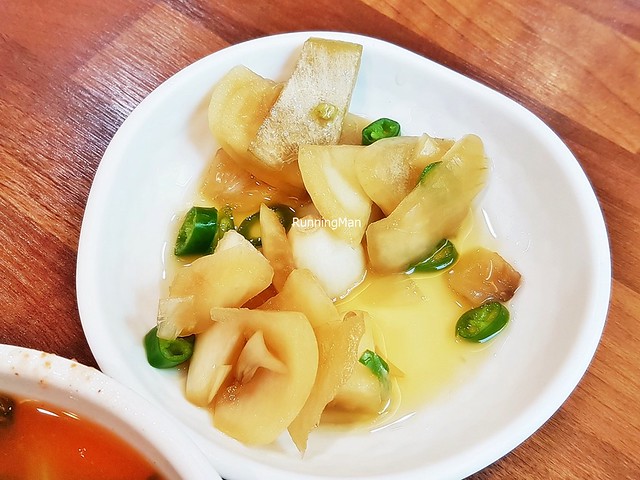 |
| Yangpa Jangajji / Pickled Onions |
 |
| Yangpa Jangajji / Pickled Onions |
 |
| Yangpa Jangajji / Pickled Onions |
 |
| Yangpa Jangajji / Pickled Onions |
In Jeju & Seogwipo, in the Jeju Special Administrative Province of South Korea, Gyul / Tangerine is a very common and popular fruit. Farmed tangerines are used as ingredients in several dishes, or eaten on its own. The local variety here is more fruity sweet and less sour than other versions elsewhere, yet it feels delicate on the palate, with a refreshing juicy bite.
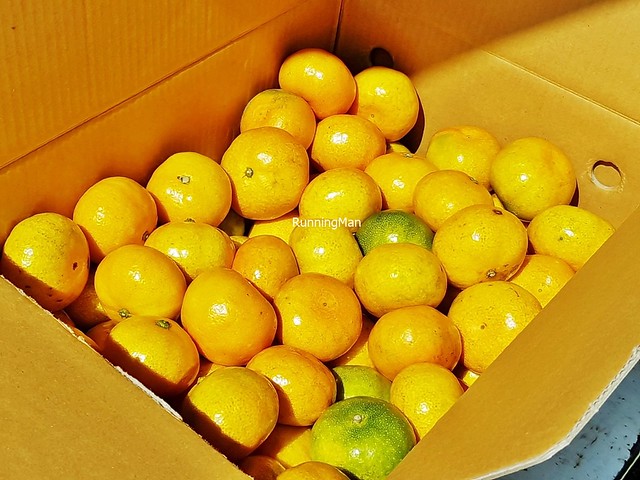 |
| Gyul / Tangerine |
 |
| Gyul / Tangerine |
 |
| Gyul / Tangerine |
Fresh Tangerine Juice is a common beverage here. Profile of the drink is fruity sweet but not overwhelming, as it doesn't contain processed sugar. The natural versions have a light orange colour, and are usually bottled in small bottles shaped like the island's signature stone statues, the Dol Hareubang.
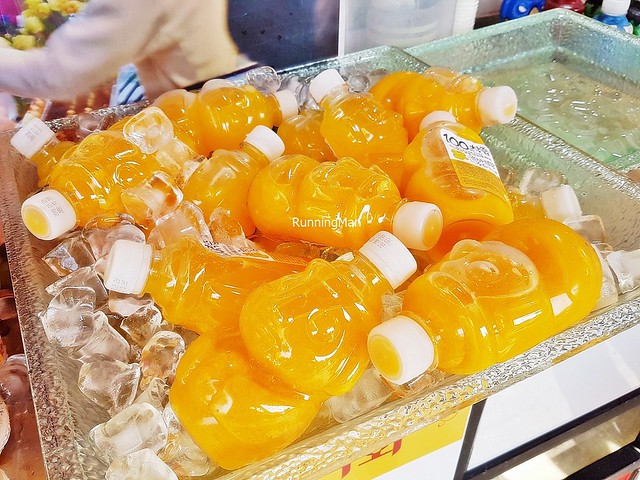 |
| Tangerine Juice |
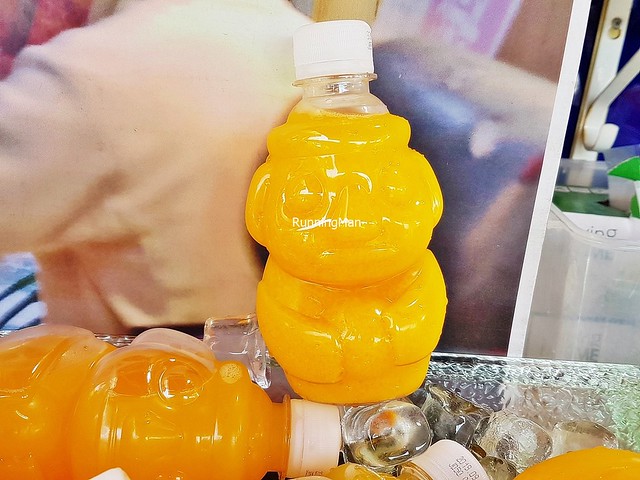 |
| Tangerine Juice |
 |
| Tangerine Juice |
 |
| Tangerine Juice |
The Tangerine Golden Cake is a local dessert pastry, consisting of a soft fluffy tangerine infused sponge cake, filled with a rich thick tangerine syrup. Bright and fruity sweet in flavour, the tiny pastry is shaped like the island's signature stone statues, the Dol Hareubang, and is sized to be eaten whole.
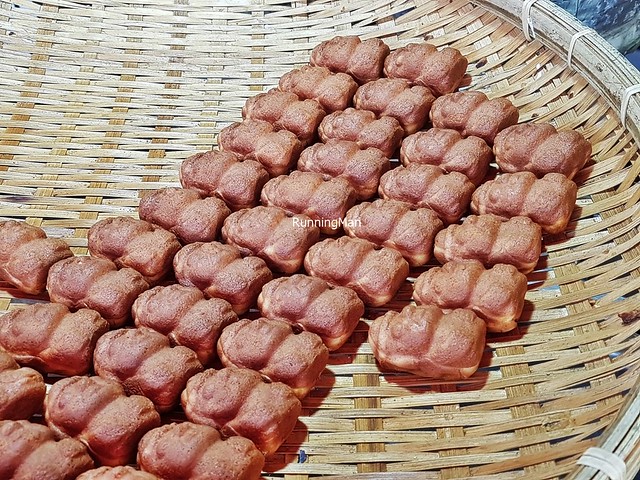 |
| Tangerine Golden Cake |
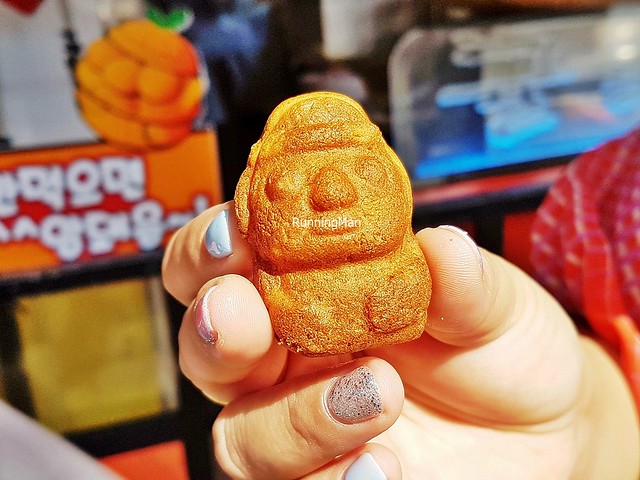 |
| Tangerine Golden Cake |
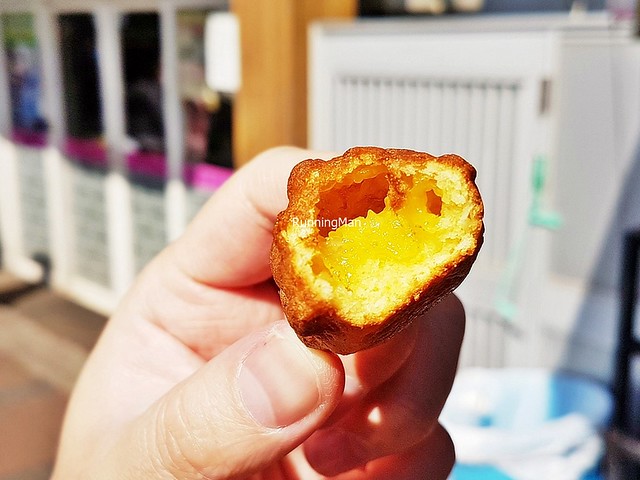 |
| Tangerine Golden Cake |
.....


CONVERSATION